Written by Tom Wright - http://life.tomwright.me.uk/
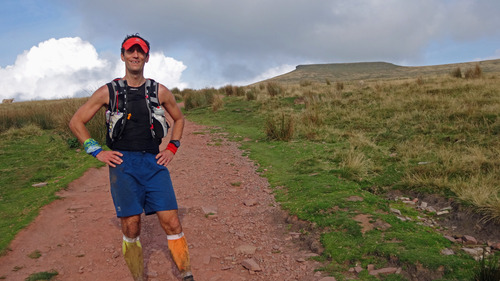
On the climb to Corn Du. Copyright Stewart Bondi (Hash name: Rambo)
Preliminaries
The race began at 5am. I was late!
The dawn glow was yet to break the jet-black of a mountain night. A light dew had gathered on the long grass making the MudClaws damp before I even toed the start line. Despite the relative comforts of a rock and roll bed in our recently acquired T4 my sleep had been unsettled. I lay awake questioning my reasons for undertaking this gargantuan task. Originally the 10 Peaks had been cause to a higher goal but I had abandoned that idea in the summer. I had proven more than enough to myself at the RAT 100K three weeks earlier and felt little pressure to do anything other than enjoy a day in the mountains. As I learnt in the spring, Welsh weather can interfere dramatically with best laid plans and previous experiences weighed heavy on my mind.
Perhaps my concerns derived more from the underlying premise of this race: self-navigation. I had laboriously formulated a route using Google Earth and a Harvey Mountain Map. Despite the jocular reputation amongst our family about my short term memory, it would appear I have a talent for memorising maps. As I lay wide awake on my bed I could visualise the entire 55 miles of my proposed route: the piles of stones; the saddles and spurs; the tarns; the river valleys and of course the peaks. Could I, however, assimilate my memory map with the terrain on the ground? The ultimate challenge of the mountain navigator.
Awake at 4am, fuelled on granola and tea, failure to consider long toilet queues accounted for my tardiness. A shorter course would be starting an hour later and with 200 people taking part, all told, patience was called for. Fortunately there was no mass start and race organiser, Mark, was calling out for any errant long course competitors as I made my way to the start control. It was time for a very long day in the mountains!
The Warm Up
Just to elucidate, the format of the Cliff Bar 10 Peaks is simple. The ten highest peaks of the Brecon Beacons National Park must be visited in the specified order, along with several additional checkpoints. The route is of the competitors choosing. A map is provided at registration with a suggested path covering 90km and 4800m ascent.
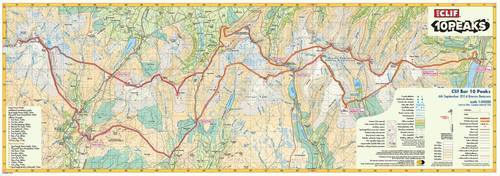
The official map of the course as produced by Harvey Maps. The short course cuts north along Sarn Helen in the middle of the map, while the long course heads to the Black Mountain on the far western edge of the Brecon Beacons.
There is no signage on the mountains. Cut-offs are fairly loose but the time limit is 24 hours. Any competitor failing to reach the second check-point by midday would be redirected onto the short course. To allow these competitors to still get an official finish we had two additional mandatory checkpoints, being the first two peaks of the short course race. So yes, we would be doing twelve peaks!
The first of these being the Hill, as the foot path sign so pleasantly pronounced, only half a mile from the start. This would be one of the longer climbs of the day, but undertaken by spotlight and with eyes still bleary in the early hours it passed quickly. Too quickly perhaps as I scored the twelfth fastest time of the day to Carn Pica.
My one memory of the climb was the incessant heat. Despite pre-dawn, the air was warm and thick. I was dressed, and packed, almost identically to the combination I donned at the RAT (other than one small technological advancement I will discuss later). This meant just a mesh vest on my upper. Yet still I was sweating!
The field was stretched once on Craig Pwllfa’s peat bogs. I knew this section well, albeit in reverse, from the spring event yet still I nearly cut left straight into the worst of the bogs, only deciding at the last to follow the flashlights ahead of me on a path that circumvented the tough terrain. Then the route took us south along Graig Fan Las.
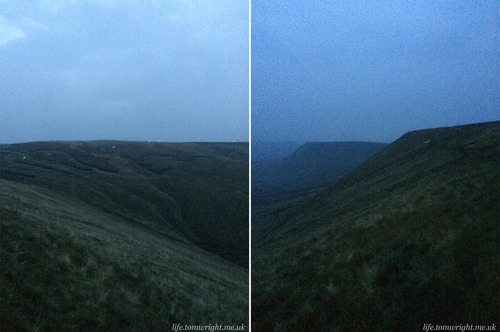
Dawn chorus on the Waun Rydd and Graig Fan Las ridges. Headlights pave the way.
The shadows of the mountains majestically took shape around us as the light of dawn gradually filled the sky. Not a time for sightseeing as the first navigational challenge of the day called for focus. We were to take a south-west bearing across open country to the Filter House south of Neuadd Reservoir. The provided map gave little clue other than a direct line drawn from the point we would cross the Beacons Way to the reservoir. I chose to cut left at a pile of stones and find a path that followed the large gully cut into the hillside by Nant y Gloesydd. As I hit the stones I was dumbfounded to see all the runners ahead of me following the Beacons Way north-west. Perhaps people were more focussed on jockeying for position than watching their compass? Although the lie was too level to give any indication of where the reservoir was, and despite the path looking very untrodden, I stuck to my plan. Soon the path became steep, and I was hugging the gully, moving at quite some speed.
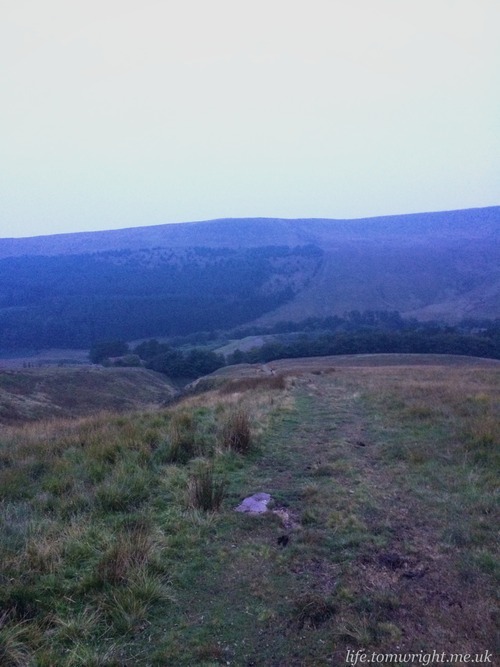
On direct course to the reservoir with a good view of the climb to Trig 642 ahead.
Looking back no runners appeared to have followed me. As I approached the reservoir I saw runners coming in from the north. I had jumped a considerable number of places, gathered huge confidence in my navigational ability and opened up the doors for further off-piste exploration throughout the day. I couldn’t help but grin at this minor accomplishment so early in the race.
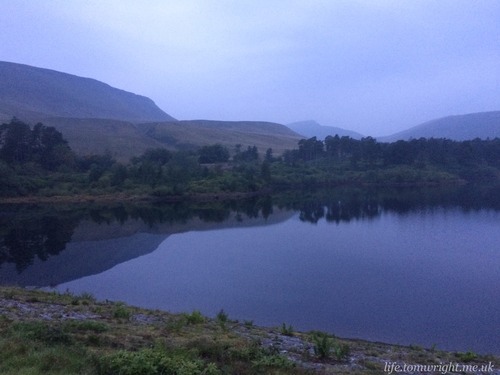
Still of the morning on the reservoir and a first glimpse of the Fan rising up in the distance.
The next compulsory checkpoint was trig point 642, followed by Rhiw yr Ysgyfarnog ridge. Familiar territory, although, unlike my previous excursion, visibility was more than ten metres and I welcomed the view across Pen-y-Fan. It was another tough climb from reservoir to ridge, with some uneven terrain and rock scrambling near the top.
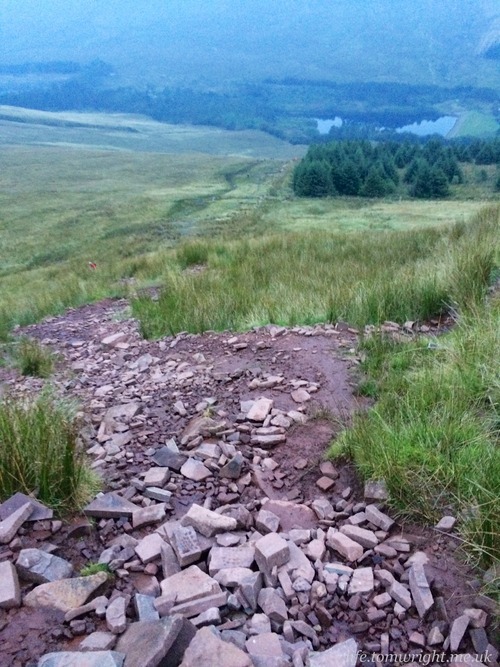
The loose rocky climb to Trig 642. Runners already quite dispersed.
A female competitor, Michelle Bowen, stormed past on the climb. I was on her tail to the col at Bwlch Duwynt with intent to reel her back in on the fast descent to the first checkpoint south of Storey Arms. However she moved exceptionally fast on the downhill showing adroit control of the terrain and was all set to leave the checkpoint when I arrived.
I got that eerie feeling of quiet that I experienced at early checkpoints in the RAT. I had come here for a day out on the mountains yet I sensed in the space of 2 hours, with one brisk ascent and a wise navigational decision, I had landed myself unintentionally in the competitive end of the field. Surely that would all change, as the real challenge began with our first official peak.
Peak 1. Fan Fawr at 734m. Arrival time 07:55
First climb and not a path in sight! Riding high on my earlier nav decisions I banked left of the steeper knoll heading for a herd of sheep in the hope they would have worked some tracks into the tuft laden and overgrown vegetation. Learning on the run I soon discovered that the vibrant greener looking vegetation indicated water and was best avoided. As the mountainside plateaued I saw the official track running up a much steeper second ascent way off to the right.
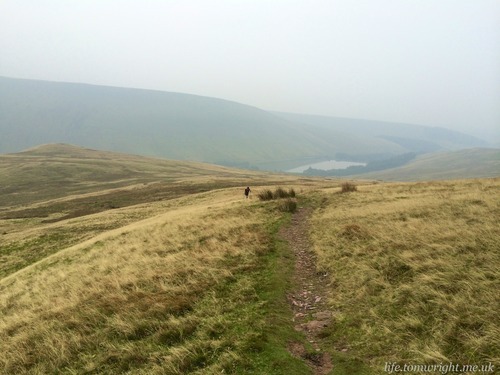
Looking back to Beacons Reservoir. I chose a slightly longer route south of Bryn Du - the small knoll on the left middle of the photo.
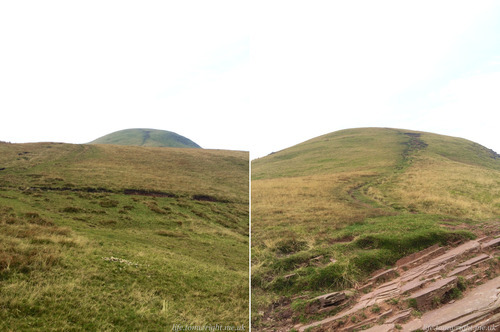
Steep scramble to the plateau of Fan Fawr.
The relief of a terraced dirt track was short lived as my legs showed the first sign of fatigue on the short steep climb. I adopted the ultra crouch with hands on quads and pushed slow and steady to the summit. As with all the western peaks the cairn teasingly sat further back on a gradual rise. Sucking in the cool air I had bagged Fan Fawr. The early morning cloud was gradually lifting and the views of the reservoir satisfying.
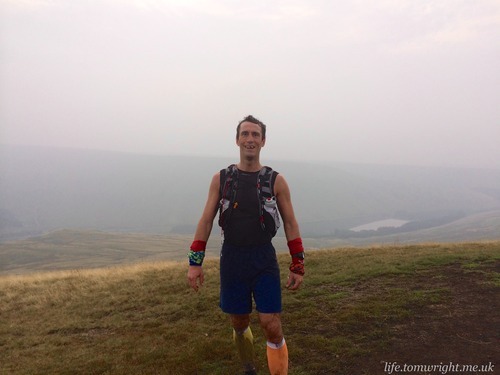
One down… nine to go! On the summit of Fan Fawr
Peak 2. Fan Llia at 632m. Arrival time 08:39
On the aerial images the landscape between Fan Fawr and Fan Llia looked remote and desolute. It was a relief to discover the path was in fact well trodden and there was no need to take bearings. This should have been one of the easier peaks but after crossing the three rivers I really struggled on the ascent to the Beacons Way. The terrain was hard work with a slow walk at best as my energy waned. Following the hefty slog to Fan Fawr I also experienced a few twinges of cramp in my calves.
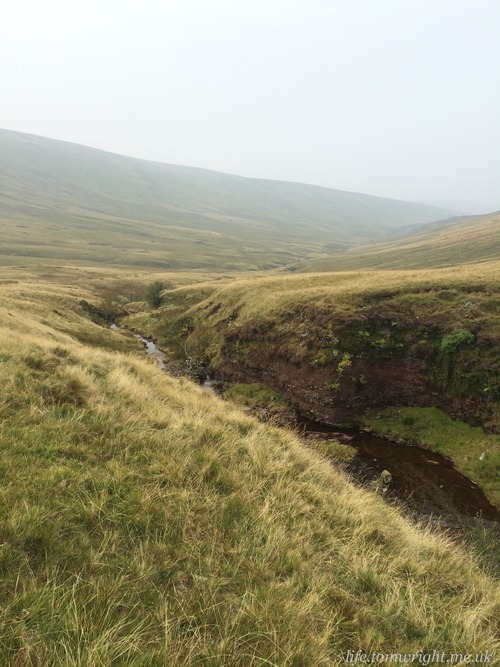
Visibility helped considerably with the bearing for the crossing of Nant y Gwair
After the crossings I lost the path and several times altered course trying to follow a sheep track that soon faded into undergrowth. The other runner had taken a more direct line using poles to push through the undergrowth. He was a distant figure on the rising ridge. Once on the official track with a gradual climb to the summit I had little desire to run. Worse still, I contemplated switching to the short route at the forthcoming checkpoint. The downside of doing the extra peaks at the start made the temptation of stepping down all too accessible. As with the unexpected cramp, I put the fatigue in my legs down to the short recovery time since my inaugural 100km. Or was it just the 6,000 feet of tough ascent we had already faced this morning? Burying the doubts so early in the day took a lot of inner searching.
Fortunately a swift and comfortable descent from Fan Llia to the checkpoint, which saw me catch the other runner, put my mind at ease. I had chosen a slightly longer, and more gradual, route following the Beacons Way which bought me out just beyond the checkpoint. I believed the shallower gradient would allow me to maintain controlled speed, and I would hit the bridge across Afon Llia rather than tackling the water.
Peak 3. Fan Brycheiniog at 802m. Arrival time 11:57
Probably fitting that the most difficult peak to pronounce (just) was also the longest peak to reach.
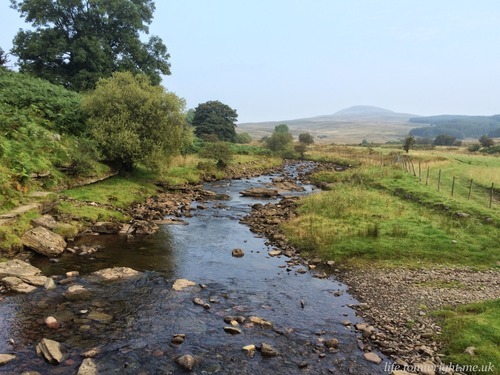
A change of scenery crossing Nedd Fechen on the Roman Road, Sarn Helen. Fan Nedd, which will visit on the return leg, looms in the background.
First we had several uncharacteristic miles along a rubble strewn Roman Road (Sarn Helen), over some open moorland and finally through limestone country to the third checkpoint.
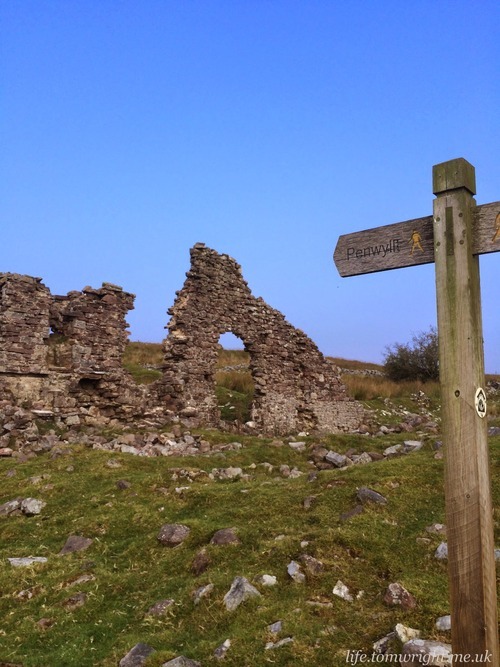
Ruins on the track to Penwyllt and the checkpoint housing our drop bags.
My mojo had returned as I put distance between myself and the runner I had shared the first two peaks with. However, the sun was now sitting high and the heat began to bake the exposed rocky terrain. I was begging to get back onto the cooler high ground. A further challenge came from an unexpected source - cattle! Not only were they reluctant to move from the main path, but they were also protecting young, and strange calls echoed across the landscape as a warning of our imminent arrival. An irrational bovinophobia just strengthened my desire to get off this alien landscape and back to fell running.
Another quiet checkpoint. But this one had food. Hot food! Despite the rising heat of an adventitious Welsh morning I was keen to savour the pasta and red on offer and foiled by warm tea I tucked into two helpings. There was an impressive array of cakes but I was steadfast with my low sugar nutritional plan.
At the same time I embraced technology. I had stowed a portable USB charger in my drop bag, which was waiting for me here. My plan was to charge my Ambit for the duration of the long climb to the third peak in the hope this extra juice would extend my watch’s life for the remainder of the course. I also had plans to change my socks, switch to some dry wrags and grab two rounds of marmite sandwiches from the bag.
However, plans were thrown into turmoil as not one, but ten other runners appeared in quick succession at the checkpoint. The fantastic staff dishing up the pasta had been quick to affirm I was in thirteenth place. But of course, I reminded myself I was here for the sights and the challenge, not to race so was content to sit back and enjoy the spread of food. Yet as the runners hurriedly switched their kit and departed with purpose a competitive urge came over me to at least attempt to maintain my position.
So I guzzled down a few extra spoons of pasta, slurped my tea, grabbed a slice of orange, expressed my gratitude to the staff and tucked in behind the lead group.
Cutting out a wide switchback of the Beacons Way we took a bearing north west over a little hillock and down some steep fields. I had planned a little short cut here around the back of the church, past the derelict pink walled Tafarn-y-Garreg inn, and over a little footbridge. It avoided a farm and possibly saved a few hundred metres. Crucially, it worked! Despite the heat, and growing fatigue my navigation brain still seemed to be alert.
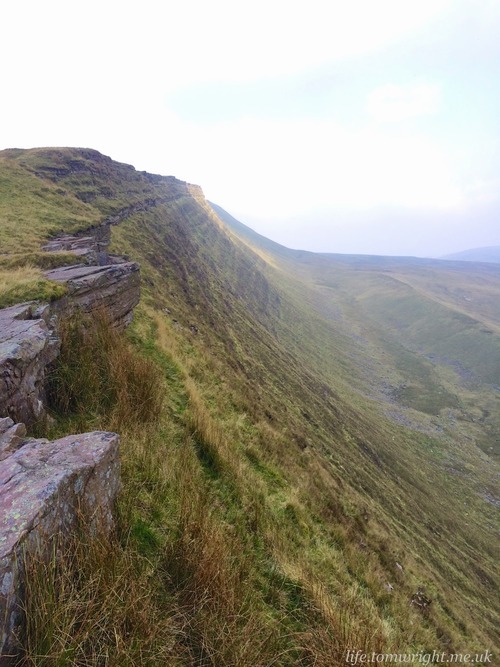
Looking over the edge of the steep eastern scarp of Fan Hir
Time for some serious ascending as we took a very steep path up the spur on to Fan Hir ridge. This was far harder than I had anticipated and I found myself stopping every hundred or so steps to catch my breath. My legs occasionally cramped up. I had been sweating heavily all morning and suspected I may have some salt deficiencies. I attempted to consume a salted Chia flapjack followed by a marmite sandwich but both were so dry I found myself spitting bits out. A few of the younger competitors in the group that departed the checkpoint were soon distant dots on the skyline. Unfortunately what I thought was the final summit was in fact a smaller peak at one end of a deep saddle. To confound my situation the descent was painful on the knees and quads.
On the plus side, the ten pound USB charger had worked. I had carried it, cables and Ambit in a sandwich bag for fear of sweat or other moisture penetrating any connections. Now with the watch back to 80% charge I was content my watch would accompany me all the way to the finish without going to sleep. So I stashed the accessories away in the bottom of my pack.
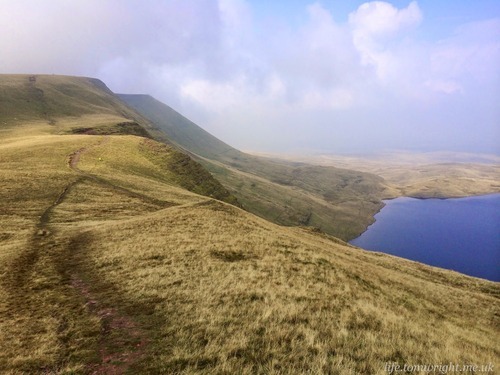
Climb to Bwlch Giedd with Fan Brycheiniog behind and Llyn y Fan Fawr down the the right.
I chatted to another runner on the final climb to the peak. He was likewise frustrated by cramp which he had never experienced in his training on these very mountains. I felt somewhat relieved that it was not just me and an experienced local fell runner was facing similar issues.
It took 75 minutes to travel 3.25 miles with just shy of 2000 feet ascent. The terrain was well walked and hard underfoot but after the initial climb the slope had been gradual. At least with clear blue skies the panoramic rolling views of the mountains had been awe-inspiring and I reminded myself repeatedly how lucky I was to experience this majestic terrain.
Peak 4. Bannau Sir Gaer at 749m. Arrival time 12:12
This swift out and back to Picws Du allowed opportunity to eye the opposition. Appearances were giving nothing away and I felt uncomfortable at how strong those in front of me looked. Of course everyone exchanged encouragement or at least proffered a smile in acknowledgement of our shared experience.
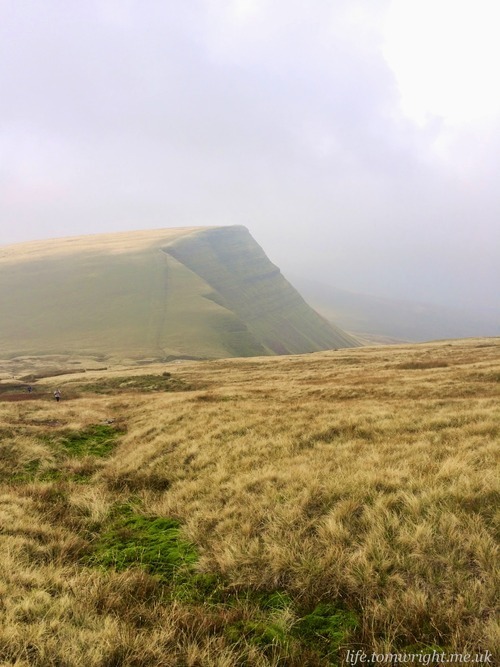
Looking west to Picws Du on Bannau Sir Gaer
The descent was back to tuft laden, boggy, mud riddled terrain while the ascent from the col was a short steep hard packed path. A bank of low cloud moved in during the ascent and the air temperature dropped instantly. While a brief respite from the sun was welcome the temporary lack of visibility was disconcerting and made me appreciate how very different the day would be if I was navigating in cloud.
The summit was a milestone. The furthest west we would travel across the Brecon Beacons today. The horizon was too hazy to make out the Fan far off in the distance but a black shadow loomed closer. An omnipresent shadow lingering in the corner of the eye since reaching the ridge of Fan Hir. The steep imposing western scarp of Fan Gyhirych awaited.
Peak 5. Fan Gyhirych at 725m. Arrival time 14:12
Before tackling the steepest climb of the day, the marshall advised us we had one little hill to combat.
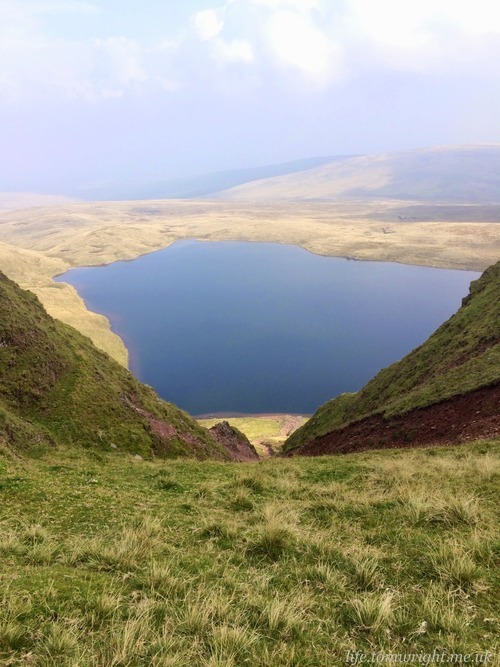
Looking down at the tarn from a large chasm at Bwlch Giedd. This was NOT the way down!
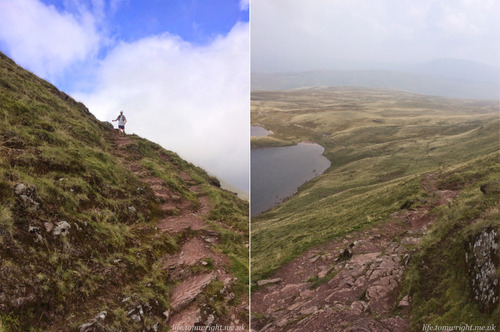
The rocky descent. Fortunately the path ran straight alongside the tarn allowing perfect opportunity to cool my head.
A steep rocky descent led down to the calm waters of Llyn y Fan Fawr. I dunked my head several times in the icy cold water. A brown film lapping at the water’s edge made the prospect of drinking it less appealing. I hoped my bottle and bladder would see me through to the next checkpoint.
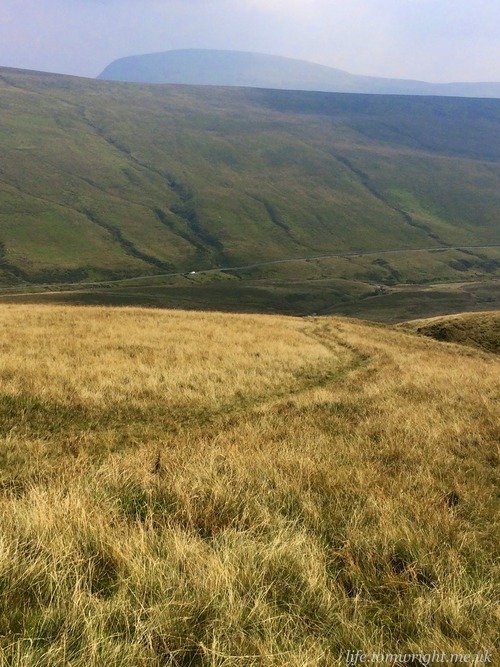
On the track heading for the lay-by where those cars are parked. The mountain looming in the background!
A small path wound along the of edge of Nant-y-Llyn river leading to the foot of the hill. The dark shadow of the mountain loomed behind. It was a spectacular sight - the David and Goliath of the Brecon Beacons. Fan Gyhyrich only stood 725m high but appeared to be so much higher.
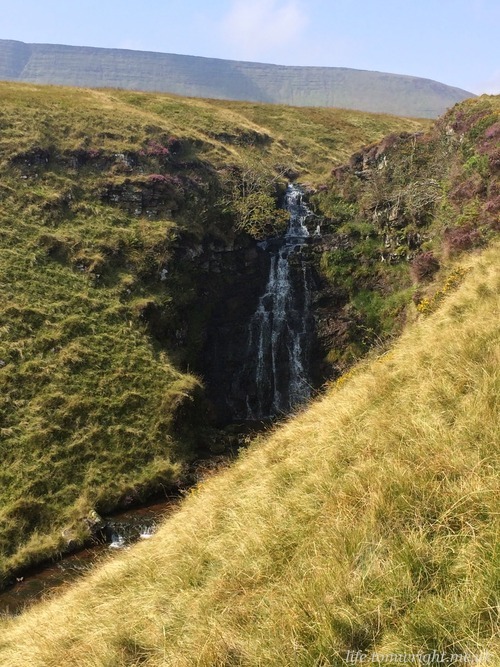
Gentle flowing waters of the Nant-y-Llyn river.
A few fresh faces followed close behind me now. As the descent steepened our travails were rewarded with picturesque waterfalls in flow despite the long spell of dry weather. I could only imagine what these rivers would be like in flood by the depth of the gorge they had cut through the landscape.
Time for focus. This section would probably be the toughest of the day. Open country, overgrown terrain, and just a few sheep tracks to follow - if they could be found.
I sought just such a track across the stile and right of the stream at the foot of the hill. It had been visible on Google Earth but with wild grass hugging my knees a path was hard to locate. An old fence post served as clue and soon enough a narrow walkable track revealed itself. I called the other runners who were across the stream fighting vegetation and they joined me. We lost the path several times on the slow hike and hit a few boggy sections but finally surmounted this hill that could have so readily been a peak and descended to the checkpoint.
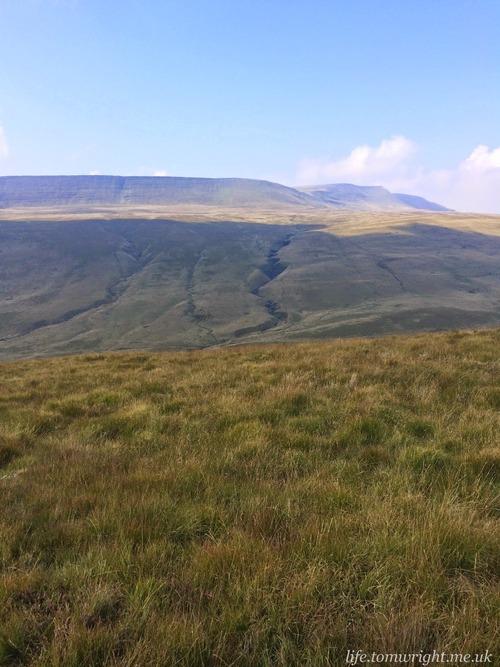
Looking back to Fan Brycheiniog from the top of the hill. The gorge of Nant-y-Llyn cutting through the landscape.
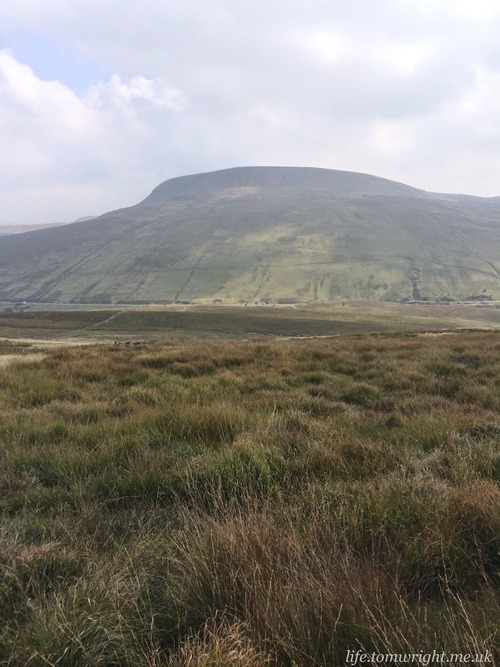
First full view of Fan Gyhyrich. The checkpoint awaits in the lay-by at the foot of the climb. The tufty terrain in the foreground gives a good indication of the footing over the hill.
I filled my bone-dry bladder and bottles and then took charge of several packs of Clif shots. My store of dry food was no longer working. Energy was depleted and in the hottest part of the day my mouth was too parched to chew on bread or bars. So, with twenty miles to go, I adapted my nutrition plan in favour of quick release sugar. I couldn’t see how else I had any hope of ascending the mountain that stood in my way.
The reputation of Fan Gy’s western scarp had preceded it. Maps don’t lie. Crammed contour lines. This was a very steep prospect! The initial clamber bought back memories of my navigational errors on the Black Mountains in April. No footpaths to speak of. Only the keenest, or craziest, hikers would tackle this challenging ascent surely! My legs were screaming and this was a far cry from ultra-running. I would attempt to climb 50 short steps, then rest, with hands on knees and curse. Walk, scream, repeat! That was the new method.
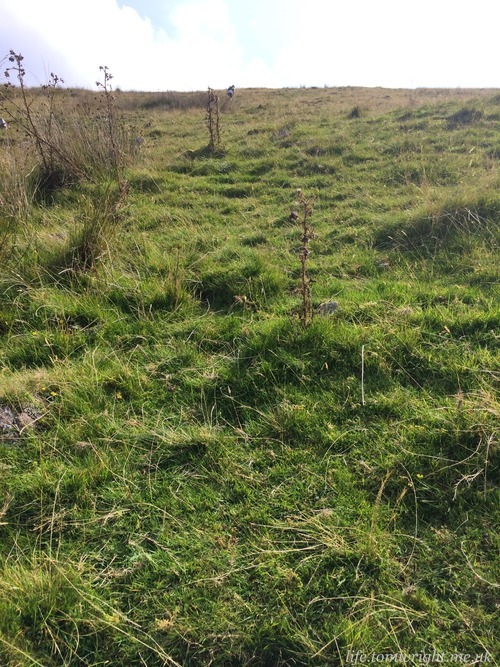
The slope was tough, the underfoot terrain just added to the anguish!
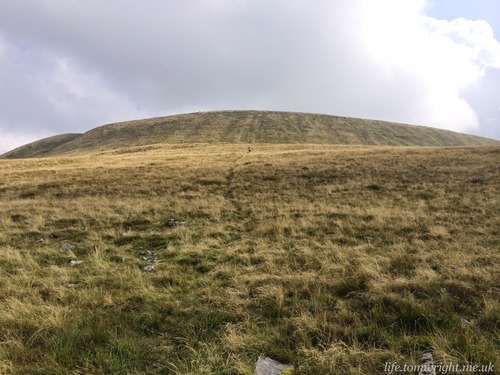
The slope levels out ahead of the final 100m climb.
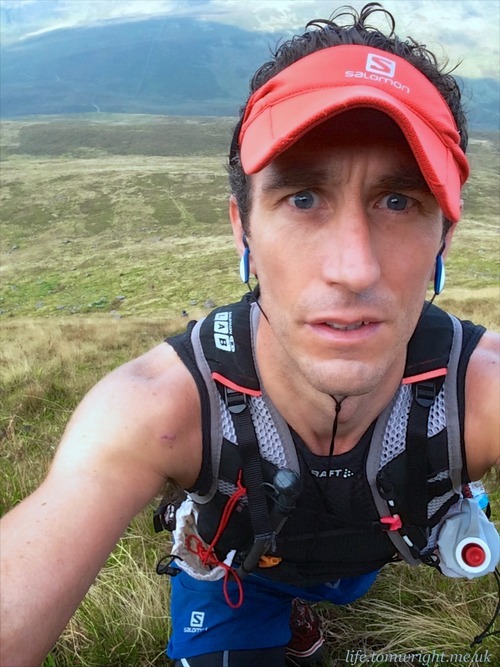
On hands and knees scrambling to the top of Fan Gyhyrich. The toughest ascent of the day (so far)!
The fact the final 100m was covered on hands and knees was affirmation enough. In fact following the form of those ahead of me by adopting a scramble over the last ascent I couldn’t help but wonder if this would have been a more efficient way to tackle some of the earlier climbs we had encountered. For a short brief spell the pain in the legs subsided, the fatigue was stymied and I actually started enjoying myself.
Five peaks down. Five peaks to go!
Peak 6. Fan Nedd at 663m. Arrival time 14:54
I had several navigational tactics in mind for Fan Nedd. Bearing west off the summit was not one of them as I made contact with the red road far earlier than expected and put a few hundred metres onto my route. My first navigational error of the day which I attributed to the exhaustion of the climb just undertaken. On a positive I could just make out Pen-y-Fan on the hazy horizon. It was getting closer.
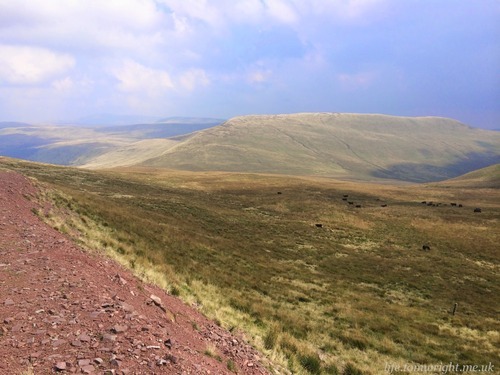
Fan Nedd awaits centre of picture. I chose to take a sheep track on a direct bearing along the edge of the mountainside rather than following the ridge to the northern trig.
I was keen to get back onto softer ground and deviated right on a small path that followed a farm wall to the foot of Fan Nedd. An unexpected bog found me waist deep in muck and stinking of more than just sweat! An unfortunate stench that lingered on the air for quite some time. Several other runners were following the ridge line to the northern cairn. I chose a direct bearing across the mountainside via sheep tracks. The path repeatedly petered out into more overgrown tufts but my legs were grateful for the slighter gradient. By the summit I had made ground on several other runners. The descent was swift and steep. I was grateful for an emergency checkpoint that had been set up by Mountain Rescue offering water. My supplies were nearly exhausted!
Peak 7. Fan Frynych at 629m. Arrival time 16:11pm
"The Romans built terrible roads", I kept telling myself as my tight muscles struggled on the rubble strewn track that wound north west. Perhaps 2000 years of torrential Welsh climate was more cause for the protrusions that jutted out and repeatedly caught the sides and souls of my feet. This was not good terrain for MudClaws and I felt several pangs of pain.
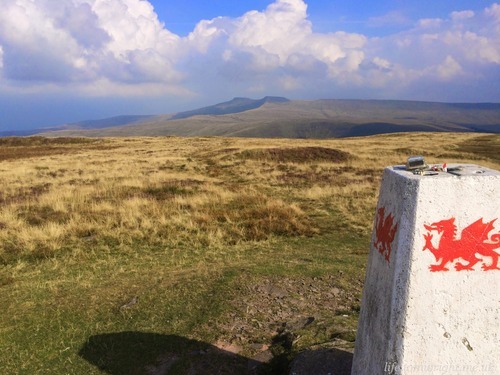
Pen-y-Fan and Corn Du almost within reach.
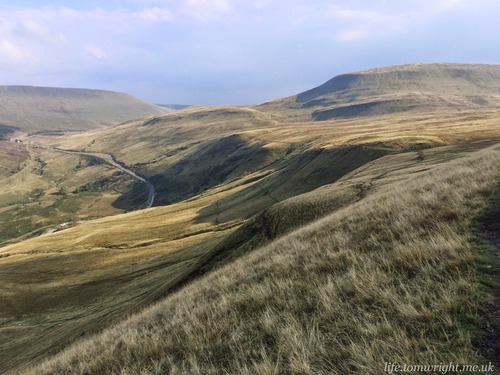
Peak 8. Pen Y Fan at 886m. Arrival time 17:54
Back on a Roman road. This one well modernised with stone-pitching. The same road on which I had rediscovered some purpose during the torrid Summer 50 as I pulled myself back from the brink of a DNF. Contemplating how excruciating that day was really put the current scenario in perspective. Yes the legs were tired but the weather was still fair with clear skies. Exiting the station I passed a couple of long course runners I didn’t recognise and my thoughts wandered briefly to my position in the field. This had been of little concern on the western section as numerous runners overtook. Maybe I was hovering in the low twenties. I had to shake off my mind’s meanderings and concentrate on the job in hand, one summit at a time.
With so many other competitors around me now I was reluctant to show weakness with the “walk, scream, repeat” method and stuck out the climb to Corn Du at a steady slow pace. Only stopping briefly to hydrate my parched throat. A very dextrous non-competitor, who I discovered later was Rambo, came bounding down the hill towards me briefly stopping to take some photos of my suffering.
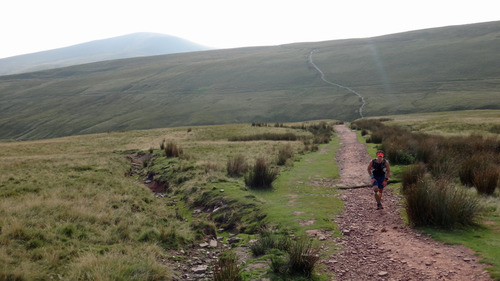
On the ascent to Corn Du. Our first peak from earlier in the day, Fan Fawr, looms in the shadows. Copyright Stewart Bondi (Hash name: Rambo)
At the crossroads I had the option to bank right to the col and skip Corn Du entirely as it was not a mandatory peak. I decided the view would be far more rewarding going to the summit and why not add a thirteenth peak to the journey.
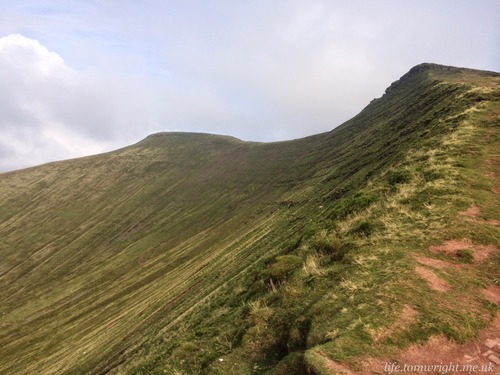
Corn Du and Pen-y-Fan
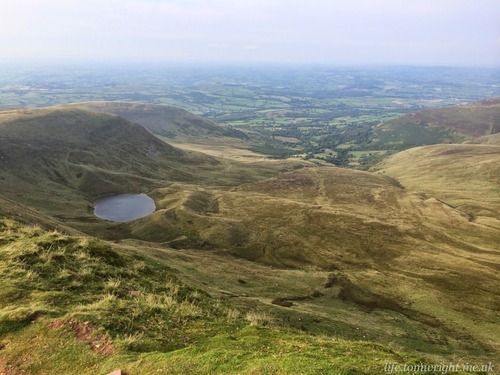
The valley to the north with Pen Milan on the left
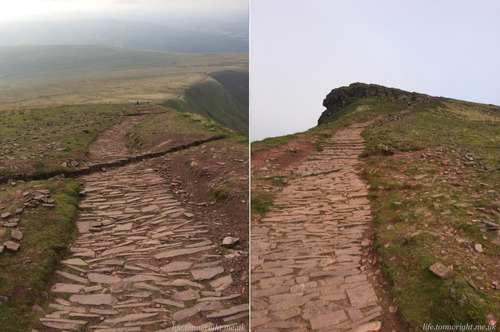
The final path up to the summit of Corn Du
From Corn Du it was a simple matter of a short descent where I attempted to generate some speed to carry me up the slope to Pen-y-Fan. Gravity carried me about five metres before my legs stopped dead and it was back to the slow plod. It was a great relief to finally reach the summit of the highest peak which had looked so distant when I spotted it in the haze from Fan Nedd.
Peak 9. Cribyn at 795m. Arrival time 18:16
It was was just under a mile to Cribyn following a steep rubble path into the col and a stone-pitched path up the other side. Occasional low cloud swept through but rarely long enough to conceal the target and spectacular views just kept flowing.
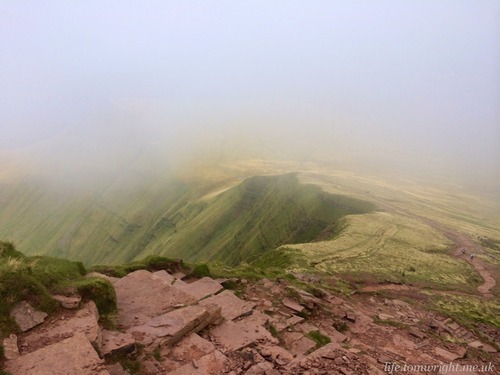
Stoney descent from Pen-y-Fan while Cribyn hides in the clag

Down the valley to the Neuadd reservoir which we had passed in the early hours of the morning.
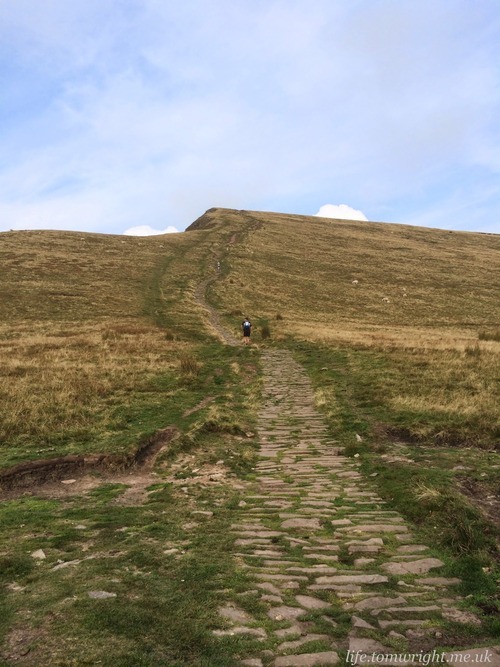
The ascent to Cribyn
Gazing up at the imposing hundred metre climb to Cribyn I sought distraction. My phone had reception so I decided to phone the family and let them know my progress. The girls were sat on the sofa, watching athletics and tucking into pizza. The thought was tempting but hey, I was in the mountains and it was awesome! After a quick chat with our oldest daughter we said our farewells and I set off with purpose to yet another summit.
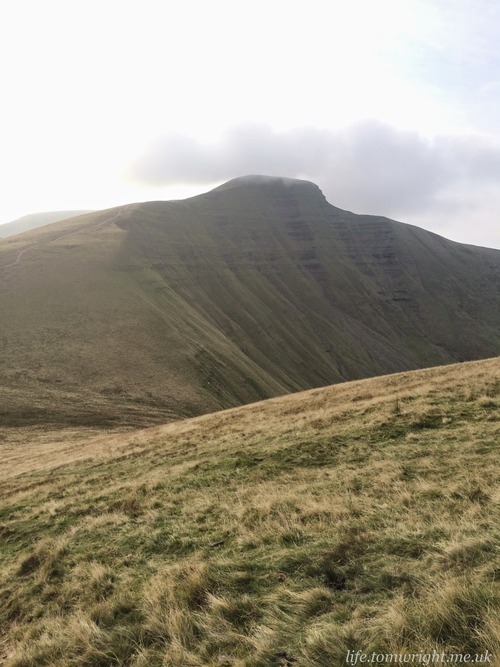
Pen-y-Fan from the climb to Cribyn.
Peak 10. Fan y Big at 719m. Arrival time 18:37
How fitting that my adventure should end on the peak that I battled so valiantly with on my last visit. That peregrination was conducted in dense clag which hid the true summit as we followed a signed path around the perimeter. It shouldn’t have come as surprise that I faced one last steep climb to bag my final peak of the day. At least the path was well trodden with a well pitched switch-back. My legs welcomed this indirect but less intense avenue.
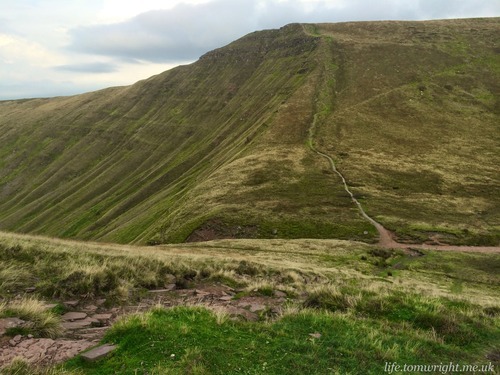
Just one more climb to go! Fan-y-Big awaits.
So, eleven hours after I had set off from Storey Arms on the first official climb to Fan Fawr, I had finally conquered the ten peaks! It had been an awe-inspiring experience. The landscape never ceased to impress and clear skies rewarded my efforts with sweeping vistas at every turn.
It was undeniably painful and the hardest challenge I have ever undertaken. I had climbed just shy of 15,000 feet, my legs screaming in pain but never faltering.
I took trust in my hired timing chip but as added proof here is a selfie on each of the summits in turn. Clear skies on every one! Who would have predicted that in South Wales?
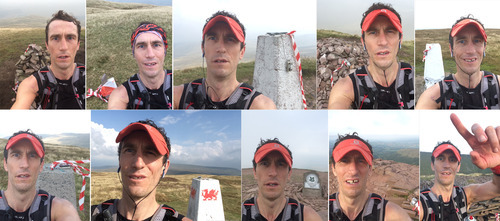
Fan Fawr, Fan Llia, Fan Brycheiniog, Bannau Sir Gaer, Fan Gyhyrich, Fan Nedd, Fan Frynych, Pen-y-Fan, Cribyn, Fan-y-Big. 10 Peaks Conquered!
The Run In
All that was left to do was attempt to traverse the final six miles back to Talybont reservoir in less than 90 minutes to go sub fifteen hours. All energy was spent and I adopted a run/walk around Craig Cwareli. As much for caution as the uneven track cut close to the vertical cliff face. The sun was low in the sky now and whispers of clouds hugged Pen-y-Fan. I thought of other competitors, the walkers, still way out on the western fringes of the course with a whole night of trekking ahead of them.

Pen-y-Fan and Cribyn silhouetted against the setting sun.
In the peat bogs I was reduced to walking. I knew from Carn Pica it would be downhill all the way to the finish so convinced myself I was banking some energy, and pain, for the final two miles by taking it easy over the bogs. I had time in hand.
High above on Carn Pica, the setting sun painted glorious hues across the valley interspersed with long shadows from the surrounding mountains. Talybont reservoir was in sight and it was downhill all the way. My legs were tight on the near vertical descent and I took it steady but as the gradient levelled I let gravity take hold and my stride increased. Two fellow competitors were in my sight. Weaving down the track off Twyn Du I caught one of them. Then for no reason I had a desperate urge to go to the toilet! Something I hadn’t done for much of the day and not the first time such an indiscretion has come over me in the vital final throes of a race. I had little option but to attend to the call of nature.
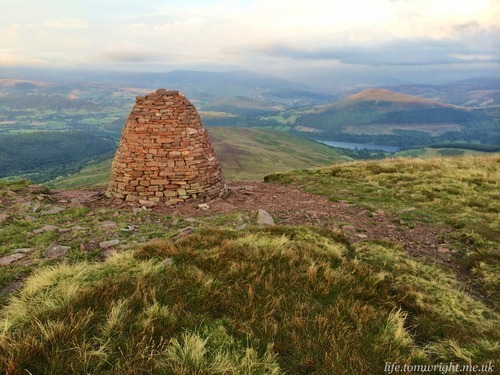
The familiar sight of Carn Pica cairn as late afternoon light and shade illuminates the valley below.
When I finally rounded the farm I saw several runners now making their way across the reservoir but despite running as hard as my legs would allow over those last few hundred yards I wasn’t going to catch them.
The slight glimmer of a race on that long descent helped pull my time inside fifteen hours. Thanks to my late start I also leap-frogged the runners I was chasing and finished in thirteenth. The same position I found myself in at that hot feed station nearly ten hours earlier. It had been a very long day. Bed was calling but not before a tepid, but still much appreciated, shower, hot food and, of course, the obligatory local beer.
This was a very well organised event. The checkpoints were admirably stocked with Clif supplies and the hot and cold cornucopia of provisions at the hot feed station in Penwyllt were appreciated. Served up by a team of volunteers all dressed to amuse I should add! I was especially touched to see all monies from sales of goodies (and photographs) going to charity. The team at Ten Peaks put on an unsurpassed challenge, for me, and I couldn’t recommend this enough.
I feel my time on the Brecons has been served. Thank you 2014 for the memories!
Written by Emily Schmidt - https://www.facebook.com/MyComradesMarathonExperience?ref=bookmarks
Comrades 2013 Up Run – Novice Report (10:56:45 Bronze Medal Finish)
As I've been relaxing by the pool in Zambia, I thought I'd start writing my blog of the day before I forget too much of all the different things that happened along the way.
I'll start by summarising the event as a whole because all the post-race talk was about how the conditions this year were exceptional (some said it had not been like this in the last 10-20yrs they had been running it, and I also heard that the weather hadn't been this bad since 1957).
Even though Comrades is held during the winter in SA, Durban still does not get that cold and so you expect it to be warm after reading that during the day temperatures tend to average 25°C (apparently, it has only rained twice - this year the rainy, overcast day was 24hrs too late!). In the week before, the forecast was that it was going to be a hot year - I read in the newspaper afterwards that it was 30°C and the hottest since 2003. However, when I was looking at the weather beforehand, I noticed that rather strong winds were forecast. I found out that in Durban they have something called the Bergwind (10-100km/hr hot winds coming off the mountains), but there was no talk of this before the race...come race day, just after half way when we had climbed ~700m the strong, warm dusty wind hit us along Harrison (not so) flats for the next 20km as we made our way to the highest point of the route at Umlaas Road.
With these conditions I found it hard to know how much to drink. I always drink to thirst as I haven't done any long enough or hot enough events where dehydration could get so severe that it could stop me being able to run. But well before half way I was wanting to drink at most aid stations (and sometimes inbetween!). Considering the aid stations are only ~2km apart, this seemed a lot to me. So then I started worrying about drinking too much, which is worse than not drinking enough (as you can die) but has the same symptoms as dehydration. The wind made it worse because within a minute or so of having a drink, your mouth was horribly dry again. If it wasn't so windy, even with the heat, I think maybe I wouldn't have wanted to drink so much as cooling your body externally with water would have been enough. At many points along the route locals had hosepipes out on the road, continually spraying the hundreds of runners as we passed. Towards the end, one aid station I passed had run out of water (still had energy drinks). Unfortunately, after the race I heard that many aid stations ran out of water for those runners further back than me.
This now brings me to the 'dramatic' stats of Comrades 2013:
- of the 18 000 that entered, ~14 000 collected their number and toed the start line
- just over 10 000 finished (4000 DNFs is the highest ever, and double that of last year)
- the rescue buses were full by the last cut-off at the top of Polly Shortts with 8km to go, and people had to walk to the finish (I spoke to someone afterwards who unfortunately missed the 2nd to last cut-off at Umlaas Road (70km), and realised that the 100's of people on the roadside weren't in fact spectators but other runners waiting for the rescue bus).
- the finishing times of the whole field were shifted; some male silver medalists (sub 7hrs 30mins) finished with female gold medalists (top 10), there was the lowest ever number of silver medals (250-300 I think, half of previous years), and they ran out of vic clapham medals to hand out (12hr final cut-off).
Media Release: CMA Medical Statistics for 2013 Race Day
The exceptionally hot weather on Race Day - Sunday, 2 June - necessitated the quick response of theComradesMarathonAssociation’s (CMA) Medical Team in treating runners requiring medical assistance.
Chief Medic, Dr Jeremy Boulter has issued the medical statistics, saying, ‘The unusually high temperature combined with an abnormally strongwind resulted in a large number of patients at the Medical Tents. However, the good news is that the medical team was fully equipped to handle the workload and all runners were treated or referred to hospital for immediate care.’
833 runners were treated at the Finish Venue at the Pietermaritzburg Cricket Oval; 366 were attended to at the main Medical Tent while 427 sought R&R, rub-downs and mild treatment at the St. John’s Tent. The majority of the patients were treated for dehydration and exhaustion.
35 patients were treated at Durban’s St. Augustine’s Hospital while 61 patients were treated at Pietermaritzburg’s St. Anne’s Hospital. Of these, four patients were admitted to the ICU at St. Annes Hospital while one patient was admitted to the Medi-Clinic.
Dr Boulter has confirmed that two of the five ICU patients have in the meantime been discharged. The rest are making a good recovery.
The CMA has over the years, implemented extensive medical, emergency, first aid and physiotherapy provisions for its thousands of participants. The Comrades Marathon’s medical provisions for Race Day have been described as ‘possibly the world’s largest temporary medical facility outside of a conflict zone’.
Dr Boulter says, ‘The main Medical Tent usually sees an average of 250 patients on Race Day but this year was different and more demanding in that we attended to 68% more patients. However, the team was equal to the task and all runners needing assistance found themselves in safe hands.’
***ENDS***
Statement issued by the CMA Media Officer, Delaine Cools on Tuesday, 4 June 2013
Now I'll take you through my Comrades experience, and what an experience it was - I'm not sure that I'll be able to explain how amazing it was (you'll just have to do it yourself), but here goes...
Checking into my hotel I was informed that breakfast on Comrades day would be from 3AM - great! Not so great was that they didn't seem to be able to book a taxi for me at 4:15AM. I didn't quite understand as the hotel was full of runners, but reception just shrugged their shoulders. So I asked all the different staff as I came and went over the next couple of days, and finally one of them made a phone call and apparently a taxi was booked for me. I wasn't completely confident in this, but as there were so many runners around I just thought I'd have to walk with them if it came to it (~40mins on my feet that I could do without before the run).
Through the runners world forum I knew that another UK runner was staying at my hotel - we arranged to meet for this 'taxi' at 4AM (race starts at 5:30 and it is recommended you are there around 4:30, and in your pen by 5 at the latest). So I set 3 alarms for 3AM to give me plenty of time to get ready (vaseline and suncream - factor 50 worked a treat!) and have breakfast. There was no need for the alarms really as I was awake from about 2AM with excitement (I went to bed early, but don't think I fell asleep until sometime after 10:30PM).
For me, breakfast was when the Comrades atmosphere really started - everyone kitted out ready and, having a blue number as an international runner, that was when everyone started welcoming me to SA and telling me to take it slow and walk early on. I was good at breakfast (nothing new on race day!) and even though there were pancake and full english options, I stuck to toast and jam. Incidentally, I read that Bruce Fordyce (9 times winner) said that he didn't have breakfast before comrades as he ran fast enough to finish in time for brunch, ha.
You'll never believe it, but when I met the other UK runner in reception, our taxi was there waiting. We were dropped off one block from the start where plenty of other runners were making their way down the street. Already people were sat in the start pens. So I went to the toilet (only a 4 person queue at the time) which had paper so I donated the roll I had bought with me from the hotel, and went to join the people sat in pen F (4hrs-4hrs 20mins marathon qualifier). What I liked was that you could drop your finish bag at the expo the day before, so no rushing around looking for the baggage trucks. I was sat in the pen from about 4:40, so don't know if there was any panic with people unable to get in. For me it was all very calm with people sat quietly. It was also rather warm, and I didn't really need the jacket I had with me.
Just after 5 everyone stood up as they removed the tape between the pens and we all squashed forward. At this point I thought I had better turn on my garmin so that I didn't forget - it took a bit of time to find satellites, but the street was quite open so it got there in the end (I didn't use the heart rate monitor for fear of chaffing). I also had a banana that I picked up at breakfast.
Then just after 5:15 the SA national anthem was played (which everyone around me joined in), followed by shosholoza (quoted as the 2nd/unofficial anthem of SA). Next up, chariots of fire, and by now the atmosphere was amazing - standing in the dark with 1000's of others contemplating the 87km that lay ahead (but trying not to think about it at the same time). Finally, after >6 months of training, it was Comrades day! I think the reason they play chariots of fire before the gun is that it can go on and on and on until exactly the right time. At exactly 5:30 Max Trimborn's cockerel crow and bang the gun starts Comrades 2013...I press start on my garmin and we stay where we are. Slowly we creep forward, and I think after ~4 1/2 mins I crossed the start line (blinded by the floodlights).
You start by running through the streets of Durban, but within a couple of km you are steadily climbing out of town. The atmosphere in the dark is great - lots of supporters even before 6AM, particularly along the bridges that pass over the road we are running along. The high-pitched shrieking/hollering sound that the SA make really made it feel like a party/carnival.
Most people around me didn't seem to go out too fast and I was running at 6:30-7mins/km (on target) near the 11hr bus. It was incredibly humid and I felt like I was sweating as I do in a bikram yoga class. I was also thinking I would sweat away all the factor 50 sun cream, but thankfully by the end I wasn't pink at all.
Even though I had been warned before and during the run about the catseyes in the middle of the road, I still managed to have a few near misses catching my feet on them (both in the dark and later on). Steadily I pulled away from the 11hr bus, but I thought this would be OK as I wasn't running quicker than 6:30/km. I also made sure I walked early (from about 3km), but the climbs along the highway out of Durban made it very easy to remember and be disciplined in doing this.
In the first 5-10km I met many other UK runners - all of which I hadn't met before either on the runners world forum or at the expo. One even lives down the road from me, which made 3 of us there running who live within a couple of mins walk from Turnham Green Church. I distinctly remember the 1st water station as it was carnage. We had been warned and so I was carrying a water bottle. At this point it still wasn't light, so as this was also a TV point we again got blinded by floodlights. Here, I started to need the toilet and noticed some girls coming out of the bushes (blokes had been going at the side of the road right from the start). By the time I found some suitable bushes, the sun had risen and it was light. Crouching in the bushes I realised that the bushes were not quite so suitable after all, as I watched everyone running past (oops, nevermind).
All the other runners were really friendly the whole way - welcoming me to SA. Everyone knows that you are an international runner as our numbers are blue, and you wear a number on both the front and back. I also had a union jack on both the front and back of my vest. I particularly remember one guy pointing to a specific tree and telling me it was '50 miles from that tree there'. I also got many comments like 'when are you opening your tuck shop' and 'how much for a gu' as I was carrying 7 gels and 2 packs of shot bloks. I still think I had the last laugh as this meant that I took on energy (gu) after ~1 1/2 hrs and at least every hour after that, whereas the food did not appear at aid stations until just before halfway.
One SA guys decided to run with me for ages (over 10km). He was from a northwestern province and so said he wasn't used to the heat either. At each water station he would drown himself in water and bring water for me (which in return I gave him the end of my gu - how generous, haha). Occasionally he would disappear for a while and then he would be back again. Also, he was amazed when I explained how difficult it was to get into the London marathon.
Running with my new friend took my mind off getting a migraine at ~21km. I usually take paracetamol and codeine when I first get the visual disturbance. But even though I had them with me, I decided not to take them because of all the advise against taking painkillers during comrades. I had a bit of a headache (which could have also been due to the heat and humidity), however from what I remember it had gone by half way. I also sometimes get the visual disturbance without a headache when I am wound up/stressed about something, so it could have been due to a release of all the comrades hype.
Now onto the hills, as 3 of the big 5 come in the 1st half, and this is what Comrades is known for. Incidentally, yes there are many other unnamed hills, which everyone running could easily think of a name or two for. I think they classify hills by how long they go on for, not necessarily the gradient/incline. They are right, I can barely remember Cowies (1st), other than I think this was whenI had to put my sunglasses on. Fields Hill (2nd) I remember because as well as being steep, long and winding, the camber of the road was terrible for running up. I think the worst hill for me was Bothas (3rd) - thinking about it, it is probably the steepest (but not the longest), you know it is the last of the big hills in the 1st half (all of which you have to run-walk), and you know that you are allowed to walk the remaining 2 hills in the 2nd half.
During the 1st half it was a bit surreal as we passed through a place called Westville, and many people were wearing westville running club vests - the 'westville' shouts of support really sounded like 'west 4' (runners in west london will understand, for others; west 4 is another club near where I live).
Just before half way (~39km I think) I needed the toilet again - great! I must be drinking enough. Not so great is that I didn't need the toilet again until 10PM that night - I was a little worried as heard that I should go to hospital for my kidneys if I don't go for 24hrs. There were 2 portaloos nearby, so I was good this time. Although, I chose them as only one person was waiting, but the people in there took forever! oh well, a nice gu and water break for me.
Arthur's seat is just before the half way point. This is where Arthur Newton (early, 5 times winner) used to rest during long training runs to look over the valley of 1000 hills. Legend has it that if a runner greets Arthur and places a flower on his seat, they will have a good 2nd half. You also hear that further down the field it becomes difficult to find a flower - some bring one with them pinned to their vest. This year we did not need to worry as the sponsored aid station just before this point was handing out roses, and there were plenty to go around. So along with everyone else, as I passed this point I said 'good morning arthur' and left my flower.
On the bus tour, we were told that a few corners on the decent into Drummond (half way) are a good point to tidy yourself up for the cameras - I was in no mood for this. On each ~10km split I had not made up the lost time from passing over the start line later, furthermore I had lost more time. This meant that I passed through half way in 5hrs 11mins (11mins behind the Don Oliver bronze schedule and 19mins ahead of the 12hr finish schedule), and didn't really notice much about me except making sure I took some water for the 4th hill (Inchanga) that was straight in front of me. My tummy had also started to rumble (this hasn't happened to me before) so I was on the look out for some food to keep the hunger at bay.
The longest hill, Inchanga, is immediately after half way at Drummond, and everyone (in my part of the field) walks this hill (4th). I had now resided myself to the fact that I wasn't going to make sub-11hrs (bronze medal), and so was going for plan B; a finish (sub-12hrs) - as I was behind on the recommended bronze medal timing, could most definitely feel I had already run just over a marathon for the last 5hrs and so was not going to make up time, but only get slower. I wasn't feeling too down though as despite the timings I was enjoying everything about the day so far, and had even managed to get hold of some biscuits for my rumbling tummy (awfully dry to eat whilst on a run, but a nice coconut flavour).
It was therefore at this point that I had the 1st chance to get out my camera, and I had a go at a little video diary. I was enjoying the walk up Inchanga, admiring the view and trying to recover as much as possible so that I felt good to carry on running from the top. Then there were lots of people around me, and I saw it was the 11hr bus - THANK YOU SIR ARHTUR NEWTON (that's what I reckon anyway). Normally, when you are caught by pacers in a race it is really demoralising as it means you are off your goal pace and therefore struggling, hence you don't usually manage to stay with them either. But this was different. This suggested I wasn't off my goal pace (I had forgotten Don Oliver's safe bronze paces were for a 10:45 finish). And yes I hurt a bit, but I wasn't struggling. This was my 2nd chance. I HAD TO STAY WITH THEM to achieve my dream goal. I was well aware that sometimes buses don't make their times (apparently, a 9hr bus was late and the original driver bailed at 21km or something). But I had to give it a go.
The 2nd half as part of the bus is all a bit of a blur. I stuck with my 10km cards and just focused on staying with the bus for one 10km at a time. Sometimes I would be up to 5-10m off the back if I was having a bad patch, other times I would be up at the front with the drivers. The bus definitely helped me in terms of running in that strong wind I mentioned before (which had blown over most of the km to go boards) - I tried to stay in the middle of the pack, shielded as much as possible. I heard that some people don't like buses because of all the singing etc., I don't know if it was the drivers we had or the conditions but this bus suited me - everyone was still friendly and occasionally chatting (particularly to me with my blue international number), but the atmosphere also seemed like 'we were there to do a job (sub-11hr finish) and we will get it done'.
A lot of the time whist we were running it was just the rhythmic sound of (shuffling) feet, and then everyone would clap and cheer in a congratulatory way (that we had made it another 1-2km) when we slowed to walk for a bit. The driver would count down (3-2-1 or 1-2-3 in another language) when we were about to start running again or slow to a walk. We also had to keep putting our arms in the air every so often (I think to relax?), and he kept reminding us to relax when running difficult parts (i.e. hills). It was definitely a group effort and everyone would pass spare water etc. around between aid stations if you needed it/missed it (the guys helping the driver would come back with their caps full of water sachets).
I found the 10km that was from 40k to 30k to go and the 10km that was from 30k to 20k to go, the toughest. These were definitely the 'head down' and stick with the bus 'for at least 10km more' part. The ups and downs/peaks and troughs come and go so quickly and for no apparent reason. I tried to enjoy the highs of the ups as much as possible, and just ride-out the downs (it is true, they do go eventually). One down I distinctly remember was loosing my shoe. In the bus people run very close together and I had my shoes looser as my feet would swell, and I didn't want any of the trouble I get with bruising when I tighten them too much. The guy who trod on my heel did apologise, but just carried on. Another runner, however, stopped and let me lean on him to put my shoe back on. I also tried the salted potatoes a couple of times - if it wasn't overly salty I enjoyed it, but some bites were too salty for my liking. I got a bit disorientated and thought that I had missed the ethembeni school for the physically disabled and visually impaired. But then out of the blue, there they were waving some flags I had left the day before. High 5ing the long line of children really spurred you on and gave you some energy.
With ~21km to go (a half marathon) I started to feel much better - I started to have a cup of pepsi at some aid stations (I don't usually drink caffeine so I think this really perked me up, plus I find the fizz thirst-quenching). However, I still didn't want to feel over-confident and kept reminding myself that there was still a long way to go in which anything could suddenly start hurting enough to make moving forward very difficult. During this time I found myself really looking forward to Polly Shortts (final hill with ~10km to go), as again you are allowed to walk the whole way up (even the front runners do) and at the top is the final cut-off with 'just/only' ~8km to the finish (downhill!).
Spirits seemed high as we walked up Polly Shortts (except the guy that I asked if the double marathon had warmed him up enough for a parkrun, who was not amused). At this point I had time to do another little video diary, and I also walked most of it with the other UK runner staying at my hotel who I had last seen outside the toilets at the start (he too finished in under 11hrs for a bronze medal, that he received lying on a stretcher thanks to badly cramping legs - which earned him a photo in the paper the next day). A rescue bus also passed us on Polly Shortts - everyone was waving it passed, telling the driver it wasn't wanted/welcome here. It had a sign saying FULL anyway, and the people inside were very encouraging cheering us on.
I was surprised that I could manage ~10min/mile (6min/km) during the final few km (admittedly downhill). There was talk of whether the bus would make the 11hr cut-off, as we still frequently stopped to walk. But the drivers were confident - telling us that 11hrs was 'a piece of cake' and kept shouting 'easy, easy' to slow us down as we would get carried away. I decided not to leave the bus, as on my own anything could happen in that final few km. Plus the bus was my experience of Comrades and so crossing the line with them would round it off (even if I don't get my solo photo as Bruce Fordyce has pointed out).
We walked with 3km, 2km and 1km to go (there are a few small hills in Pietermaritzburg) and I think twice more before entering the stadium (cricket oval). The drivers got everyone chanting 'easy, easy' as we were comfortably under 11hrs. I think coming in with the bus meant the atmosphere was even louder (the cut-offs get hyped up by the commentator). It was so loud - everyone was cheering and banging on the paneling. You 'parade' around ~3/4 of the cricket pitch and go right by the international tent before reaching the finish.
10:56:44 and it's over (the bus driver and his aids celebrated for the cameras at the end). You get a medal put around your neck, someone in a suit shakes your hand to congratulate you and you get a (sew on) badge and certificate with your rough time stamped on. I forgot to kiss the comrades logo on the ground (not sure I would have got back up), but there were people to take your photo with your medal.
And then you look around you - bodies are everywhere, it looks terrible. I wandered passed the back-to-back medal and green number tents, and then in the huge crowds (of SA meeting friends and family) officials appeared as if from nowhere to direct me to the international tent. Here we are looked after very well. Loads of hot food/sandwiches, drinks (I think beer if you are quick enough) and our bags are in an area here so you don't have to go far to collect them. I soon spotted many other UK runners and talked with them about the day whilst trying to tidy myself up, rehydrate and cheer the remaining runners. Some had been there 3hrs or more enjoying luxuries such as a shower and massage.
Finally it was time for the most emotional and saddest part of the day - the final 12hr cut-off. It gets hyped up by the commentator and sitting there with your medal it feels quite exciting (although you know only all too well that it could easily be you). But then the gun goes, the music is changed and the scenes on the big screens are heart-wrenching as people are stopped just yards from the finish line. Yet still runners are coming around the stadium passed the international tent. It's almost as though we are set up - the last cut-off at the top of Polly Shortts is at 16:50, which leaves 40mins to do ~6km (sounds reasonable, but not if you have just done just over 80km in 11hrs 20mins).
With a few others we relatively quickly found our way to the buses to take us back to Durban, and practically got straight on one. Then we just sat there for ages as the traffic getting out was chaos. The driver was nice and let people off and on the bus when they weren't feeling so well (we were warned to bring sick bags off the plane). Having left 5-10mins after the 12hr finish, we finally got back to the Hilton (where most internationals stay) at ~9/9:30PM (after what seemed like dropping each SA on the bus specifically to where they wanted in Durban). I was hobbling quite badly now (like after my first marathon), but went for a beer and some food in the hilton to celebrate with some other UK runners. Funnily, when I got in the lift at my hotel, one of the SA in there that chatted remembered me from the 11hr bus and was pleased to hear that I finished with them.
Next morning I woke quite early (so did most others it seemed), and I could walk relatively normally (just like after any other long run). I enjoyed a full english at the hotel (everyone was in their comrades tshirts at breakfast), bought the paper with the results and chilled out for a bit. Unfortunately it was raining (like I said, 24hrs too late) so not really balcony weather. Then the other UK runner at my hotel and I went along to a bar on the beach front where everyone was meeting up. What followed was a very enjoyable afternoon drinking beer and talking all things comrades 2013 with other UK, Irish, SA and UK from Dubai runners. One thing I particularly learned here was how to be gracious if it's not your day/you don't get the result you were after - some runners missed their goal medals, and others (going for their green numbers = 10 finishes) DNF'd. But all were still happy to celebrate everyone's achievements and share their stories (past and present). And most were already talking of settling scores/green numbers/back-to-back medals next year...
My Comrades Stats:
- 86.96km (garmin said 88km) 10:56:45
- Cowies Hill (16.86km) 2:04:20
- Drummond (42.96km) 5:11:13
- Camperdown (60.66km) 7:27:42
- Polly Shortts (79.26km) 10:01:48
- Fairly even average pace per km at each of the above splits (7:37, 7:24, 7:38, 7:59, 7:55)
- Overall position = 5869 (/10186 finishers)
- Gender position = 840 (/1953 finishers)
- Female age 20-29 position = 62 (/173 finishers)
- x6 gu
- x3 shot bloks
- x2 pieces of banana
- x2 handfuls (~3) of biscuits
- x3 pieces of salted potato
- ~4 cups of pepsi
- unknown number of water sachets
- x2 toilet stops
- no blisters
- mild (post-run) chaffing
- x1 migraine
- x1 tight lower left calf
- x1 accidental press of buttons on garmin (to record a ‘lap’ of 245m)
- x1 loosing shoe incident
- numerous sense of humour failures
- uncountable number of ‘running highs’
- x1 Comrades bronze medal
Written by Emily Schmidt - https://www.facebook.com/MyComradesMarathonExperience?ref=bookmarks
Last year I ran my first ultramarathon; the Comrades Marathon in South Africa. The 2013 54mile/87km ‘up’ run between Durban and Pietermaritzburg was abnormally hot and windy, but I was extremely pleased to complete it in 10hrs 56mins for a bronze medal. Although it was a very tough run, within 24hrs I had decided that I would like to return in 2014 for the 56mile/89km ‘down’ run. Apparently you aren’t a true Comrades marathoner until you have completed both the ‘up’ and the ‘down’ run, and as an added incentive novice runners who complete an 'up’ or ‘down’ run in succession are awarded a special back-to-back medal. ‘Up’ and ‘down’ are deceptive terms for the route between coastal Durban and inland Pietermaritzburg at an altitude of 1955ft/596m because you run through the Valley of a Thousand Hills, and even in the ‘down’ run there is over 4000ft/1300m of ascent.
I entered Comrades 2013 whilst training for my second marathon. After hearing about Comrades on the Marathon Talk and Talk Ultra podcasts, it grabbed my attention in an unexplainable way and I was determined to run it one day. I didn’t think it would be so soon, but when entries opened towards the end of 2012 I thought ‘why not?’ The event has such a great history to it and really does live up to its marketing as ‘The Ultimate Human Race’. I wish everyone could get to experience it someday. I would recommend Comrades as a first ultra because the size of the field is similar to that of a city marathon, so you are never running alone. Also, being on closed roads there is no navigation required, and with aid stations every 2km you don’t need to worry about carrying your own hydration and nutrition. Plus the support along the route is incredible!
Throughout my training in 2013 and 2014, I found the Comrades thread on the UK Runner’s World forum a great source of information and motivation. There’s such a variety of runners on there (speedy and not so speedy), from novices to back-to-back medallists and those with green numbers (10+ finishes). Just before heading out to South Africa big lists are made so you know which flights people are on, where people are staying, who is going to parkrun and what post-run social celebrations are happening. This year I met my first fellow comrade on the bus to Heathrow.
‘International athletes’ (as we are called) are treated so well in South Africa and by the Comrades Marathon Association. There is a special area at the expo to collect your number and chat with other runners over tea and biscuits, whilst South Africans have to queue for a couple of hours. There are bus tours of the route on which you get to see just how bad the hills are (even the bus struggles), and also visit the Comrades Marathon House (museum), be entertained by the pupils at Ethembeni School for the physically disabled and visually impaired, stop at landmarks along the route such as Arthur’s Seat and the Wall of Honour, and see inside the finish stadium. At the finish there is also an international tent to relax in after your run; only international spectators and runners are allowed in here, where your tog bag is ready to collect and there is food and drink (including beer). The area is also along one side of the finish, so you can cheer runners around the stadium and watch the dramatic cut-offs on the big screens. The various cut-offs during the Comrades Marathon are very strict (x5 along the route), and the final 12hr cut-off at the finish is a very sad and emotional experience; everyone shouts and cheers to encourage as many runners as possible to finish, but when the gun goes there are still runners streaming past and on the roads outside the stadium.
With this year being a ‘down’ run it meant getting to the start (5:30AM) in Pietermaritzburg from Durban (I stayed on the beach front in Durban like most other international runners). So after only a couple of hours napping (I couldn’t really call it sleep), I was on one of the coaches you can book to the start with hundreds of other runners at 3AM. We arrived in plenty of time, and thanks to the knowledge of a 14 times finisher found some portaloos with no queues at all (and being cleaned every time someone left one), so I was comfortably in my start pen by 5AM. To enter Comrades you have to qualify by completing a marathon under 5hrs. Like many other events your qualifying time determines your start pen which can be important for slower runners as it is timed gun to chip, and with the narrower streets in Pietermaritzburg apparently you can take up to about 10 minutes to cross the start line. The start is very emotional with all the nervous tension after months of training, all the South Africans join in with their national anthem and then they sing Shosholoza (2nd/unofficial anthem), this is followed by Chariots of Fire, Max Trimborn's traditional cock-crow and the start gun.
I passed over the start line after about 3 minutes, and the aim for the next hour was to try not to trip over whilst running through the dark streets of Pietermaritzburg. Even though it is early, there is lots of support already. Luckily there were more bushes in town than I remembered from the bus tour as I had to stop for a wee after only 15 minutes (maybe worryingly I didn’t need to go again until I got back to my hotel, oops). After 8km you reach the top of the first major hill out of the ‘big five’; Polly Shortts is the infamous sting in the tail on the ‘up’ run and nearly everyone walks up it, so it was lovely to run down as the sun started to rise. However, I was slightly worried that I could feel the effects of downhill running in my legs rather more than I should at this early stage knowing that the ‘down’ run is renowned for crippling your quads (descend 500m in the last 15 miles). The first half of the ‘down’ run is through the countryside, so it is relatively quiet. Although lots of people from the poorer, rural communities come along to clap and cheer whilst also waiting for discarded jackets, t-shirts, hats and gloves the runners no longer need once it starts to get warmer. I was glad of the advice to keep my jacket on after the first climb because you then descend again into much cooler valleys (you could see your breath and your sunglasses steamed up). After discarding my jacket, the support from fellow runners really started in earnest as I had union jacks on my vest so everyone wants to chat to you and welcome you to South Africa. International athletes also have a blue number which catches peoples’ attention, however this year because I was going for my back-to-back medal I had an orange number which means you get a lot of premature (anything can happen!) congratulations.
Next you pass through an area of chicken farming which is very noticeable by the smell, and the towns of Camperdown and Cato Ridge are pockets of such noise and support after the relative quiet of the countryside. Harrison Flats is actually not so flat, and seems up hill on both the ‘up’ and ‘down’ runs if that is possible. Just before reaching the second big climb (Inchanga) the pupils from the Ethembeni School for the physically disabled and visually impaired line the route giving ‘high-fives’ to all the runners, which is incredibly up-lifting. On the ‘up’ run Inchanga is after half-way and anyone finishing in 11-12hrs can afford to walk up this hill, however, being just before half-way on the ‘down’ run, route advice I found was that you really have to run-walk it. At this point, approaching the marathon distance, I really started to feel fatigued for the first time. But upon reaching the top there is then a nice 3km descent to half-way. On the descent I was surprised to come across a club-mate from my London running club; he is a much better marathon runner than me (and experienced ultra-runner) but, as a Comrades novice, underestimated the hills and couldn’t keep to the sub-9hrs (Bill Rowan medal) pacing he was aiming for.
Half-way is a major point of reference in any event, but I was very aware of the advice I had read and heard that the real half-way point is not until the top of the third big hill (Bothas) after 52km. Just after half-way you reach Arthur’s Seat, this is where Arthur Newton (early, 5 times winner) used to rest during long training runs to look over the Valley of a Thousand Hills. Legend has it that if a runner greets Arthur and places a flower on his seat, they will have a good 2nd half. It worked for me last year, but this year there were no flowers being handed our beforehand, so I found a (prickly) bit of greenery and said good morning to Arthur. I don’t normally suffer from chaffing, but this time under my arms was really bothering me so I started keeping an eye out for some Vaseline (at one point when I got closer to a spectator, I realised she was actually holding dip and found this very disheartening). Everyone is really helpful along the route, and it wasn’t actually long before I had generously covered myself in Vaseline which then meant I didn’t feel the chaffing for the rest of the run (until I got in the shower afterwards, ouch!). I now knew that I could walk all the up hills and should still finish before the cut-off (12hrs) for a Vic Clapham medal, and if I minimised my walking on the flat/downs I should be able to finish under 11hrs again for another bronze medal.
With about 20 miles to go I was feeling rather rough and the nausea didn’t subside until a couple of hours after finishing. I got my hydration and nutrition very wrong and couldn’t face eating anything from just after half-way, so I survived on coke and energy drink which was simultaneously thirst-quenching and stomach churning. The cloud cover we had been blessed with for a lot of the run had now disappeared and it was starting to feel rather hot (I later read that it reached 30°C in Durban). I remember being rather rude to one runner who was asking me where I was from during a bad patch, I grunted that I couldn’t really talk at the moment and he very politely explained he was just trying to take my mind off the running. I did manage to apologise though and we continued to run along together for a while in silence, which was nice and really helped me more than he probably realised. The crowd support builds and builds as you get closer to Durban. Running through Hillcrest I heard on a radio that the Russian Nurgalieva twins (dominated the ladies field for the last 11 years) had come 2nd and 3rd, but they didn’t say who had won. Brit Ellie Greenwood (who lives in Canada) was a real contender for the win (4th in 2011, 2nd in 2012), so I was keen to find out the result. Asking spectators I got told to ‘worry about my own run’, but it really lifted my spirits when I found out Ellie had won (another Brit, Jo Meek, came 5th).
With just over a half-marathon to go, you reach the 4th big down, Fields Hill. This is 3.5km long and so advice I had read suggested taking walk breaks even though it’s downhill. I chose to run the shorter but steeper racing line, although I kept thinking about what I had read on how you had to be careful not to completely trash your quads at this point (still 21 undulating km to go at the bottom). At this point I was again surprised to come across another runner who I knew was aiming for sub-9hrs. I was unsure what to say to him (and if I should say anything at all), but he seemed in good spirits and had re-adjusted his goal for a ‘comfortable’ sub-11hrs finish (this was his 15th run). For the rest of the run I leap-frogged back and forth with him and the other runner I mentioned from my London running club. Then with about 14km to go, I got a stone in my shoe. Disaster, I was in no shape to bend down and remove it. So I tried approaching some spectators and before I could speak, they asked me if I was OK and if there was anything they could do to help. With military precision I was told to lean on one of them whilst the other quickly removed my shoe (and the stone) and very efficiently put my shoe back on again. Comrades is fantastic in so many ways.
Unfortunately, after climbing the last of the big 5 hills (Cowies) and with 7km to go I got terrible cramp down the inside of my left leg. The sort of cramp that suddenly stops you mid-run, causing you to do a funny hop to continue moving forward and makes everyone around you take an audible ‘ooooo, ouch’ intake of breath. Again everyone wanted to help, but I remembered a friend telling me never to stop if you cramp and I managed to walk it off. Running then felt much smoother again, but I found if I pushed the pace too much (it was largely downhill now) I cramped again so had to try and consciously run relaxed to keep it away. Until a couple of months ago I had never experienced cramp in my life, then after the London Marathon I was stopped in my tracks going to meet my family by this same cramp down my left leg. The rest of the run was rather miserable because other than the cramp I felt OK to run it into the finish, but I kept being forced to walk. On the upside a South African started to chat to me as he couldn’t run much either as his hip flexor had pretty much decided to stop working, and we took solace in that we weren’t as bad as those vomiting on the side of the road.
I think the cramps only cost me about 5-10 minutes, but as we got closer to the finish sub-10:30 was looking more out of the question. But being comfortably under the bronze medal cut-off (11hrs), I walked a lot in the final couple of km as I really didn’t want to cramp in the last few hundred meters around the stadium. The (cricket) stadium finish is amazing; it’s extremely loud with everyone banging on the advertising boards. I could hear the commentator counting down a sub-10:30 finish, my South African friend managed a burst of energy to finish strong but I decided a few seconds meant nothing and enjoyed myself (although my photos suggest otherwise, but I was happy on the inside, honest).
I was now a back-to-back, double bronze Comrades finisher. Collecting medals and having photos taken is all a bit of a blur. I bumped into the runner from my London running club who finished 5 minutes before me, and made my way to the international tent where I was thankfully let in with the union jacks on my vest (a few of us had been worried because we had orange back-to-back numbers rather than blue international numbers). I found lots of other UK runners in there who had successfully earned silver medals (sub-7:30), Bill Rowan medals (sub-9hrs) and even their age category (female V60). At this point I started to go very light-headed with ringing ears, so I drank more energy drink and lay down with my feet up on a chair for a while. More UK runners joined us who had also achieved bronze medals (sub-11hrs) and finished before the final cut-off (12hrs) for a Vic Clapham medal. Watching the final cut-off is bizarre as it is so disheartening seeing the runners so near, yet so far whilst you have your medal hanging around your neck. That evening and the next day were then spent walking rather funnily, sharing our Comrades stories and drinking a fair few beers.
Written by Frank Chong - http://runnerzcircle.blogspot.fr
Arriving at the top of Fields Hill isn’t the end of the nightmare as we still needed to climb, though not as steep. As I arrived at Winston Park at about the 30KM mark, my body started to show signs of giving way. I kind of expected this but was just hoping that it will not happen. Sadly it did. I took walk breaks in between and ate some potatoes along the way hoping to regain some momentum. I also made my first toilet pee stop here and was glad to have found a mobile version unoccupied. With the discomfort I am facing, I was losing time but I kept attacking the climbs as I knew forward was the only way. And I needed to get to Drummond by 10.30AM (5 hours into the race) if I were to stand a chance to run the target set.
- Average cadence at 86rpm with highest at 137rpm at closing stages probably due to the anxiety of reaching The Oval.
* All photos credited to the respective photographers. Thank you!
Written by James Elson - http://runthroughtime.blogspot.co.uk
Comrades - 'The Ultimate Human Race', the oldest and biggest ultra in the world.
For years I'd had my eye on the race, probably since 2007 when I first started looking at the bigger one day events I one day wanted to run. In 2010 I decided to forego entering because I felt it was too much to travel and race well a month before Badwater. In 2011 I had a race number and went all the way to Durban to watch the race unfold, but had to let it pass me by with a fractured tibia. This year would be my baptism.
Comrades was 86 years old this year and had 18,000 people registered to run. Those are completely untouchable statistics in ultra land. Sparta might claim to be 2500 years old, but took a 2470ish year hiatus. Western States, the oldest trail 100, is a miserly 35 years old. In terms of field size, we are talking half the size of the London Marathon, but over twice the distance. It truly is the equivalent of any big city marathon anywhere else, but the South Africans embrace it as their own. Along with the 56km Two Oceans Marathon in Cape Town, Comrades at 89km is a major national televised event. The entire 12 hours from start to final cut off, are broadcast - live. I still can't get my head around any of that when I try to imagine it happening on UK soil - but the most incredible aspect of the race isn't the size, prestige, runners, location, difficulty or logistics, it's by far and away the support you receive from the crowds on route. I won't go on anymore about general Comrades stats, you can find them pretty much anywhere, instead I'll just talk about my experience of actually running the race.
Comrades alternates direction each year between an up run - Durban on the coast to Pietermaritzberg inland - and a down run as was run this year - from Pietermaritzberg down to the cricket stadium in Durban. This year I'd flown out with two of my closest friends, Rob and Jimmy - Rob was running his first ultra, Jimmy is responsible for having got me running in the first place by signing us up to the MdS in 2006 - and was making a comeback from a 5 year hiatus from ultrarunning. Staying in Durban we drove up to the race start 90ks away in a Nissan Micra with Dave and Mel Ross, another 2 close friends and incredibly experienced runners. Dave was running his 8th Comrades and gunning this time for a silver (sub 7:30), Mel her 2nd Comrades. Both have run well over 250 and 150 marathons respectively.
To make the startline and beat the road closures, we got up at 1:30am for a 2am departure and it HURT. I'd missed an entire nights sleep on the way out and this was a second dose of punishment in 3 days! When we got to Pietermaritzburg we head straight to Mcdonalds where we sat eating sausage and egg mcmuffins and drinking coffee, waiting out the 2 hours to the start. We walked up to the starting pens together and it was pretty cold outside at about 8 degrees C and most of the runners were dressed in hats and gloves.
To qualify for Comrades, you have to run a sub 5 hour marathon. How much quicker than that you run depends on which pen you are allocated at the start, ranging from sub 3 hour (Pen A) to 4:40 - 4:59 (Pen H). We all made our way to our respective pens, Dave and I managing to get our slots in pen A and the others ranging from B through to D, all pretty close to the front. It meant that of the 18,000 people, about 17,500 were behind us, held back by barriers and staring at us in the front like hungry wolves just itching to get forward and start.
Almost as soon as I got behind the barriers I bumped in to Terrence Zengerink. I first 'met' Terrence when we found ourselves running a section of the London to Brighton trail run together in 2007 or 8 (I forget). He had also blitzed our Thames Path 100 earlier this year in a stellar sub 20 time, managing to fit in a sub 3 hour marathon too on route to his 5th Comrades start. We had a good chat and it quickly became clear that our goals were pretty similar. We both had our hearts set on the much coveted silver medals given to those who complete the 56 miles in under 7 hours and 30 minutes (8 min mile pace), but were accepting that we'd have to see how things worked out as we went along and were prepared to work around that goal if it looked overly ambitious. I think we both felt pretty comfortable that the sub 9 hour time for a Bill Rowan medal (the next up from silver) was always going to be well within reach so to a certain extent we were pretty relaxed. We didn't expressly say 'let's stick together' because it's hard to commit to that if you've never run together before, but I think we both felt that we might just end up pushing each other along at least initially.
With 10 minutes to the 0530 starting gun, the music kicked in and the pens behind were released to join us in one heaving mass of pent up energy. The national anthem was followed by the incredibly moving shosholoza and then by chariots of fire.
As the countdown started the atmosphere was absolutely electric and something never to be forgotten. When the gun blew, Terrence started with the tips - avoid the central part of the road where the barriers get in the way, watch out for the discarded clothes and bin bags left behind by warmed up runners, watch out for the slippery cats eyes etc and instantly I though to myself wow this is GREAT I've got a Comrades pro running next to me for company!!!
I think I knew our days were going to be aligned for sure when after a few minutes we both simultaenously pulled off the road for a pee, and then 20 minutes later, for a more substantial toilet break, and re-joined the road together. Initially we ran in the dark for around an hour, the throngs of people around us, at first all with A seed bib numbers on, then pretty quickly with B, C or even D on their bibs humming past us at incredible speeds. I can roundly say we got overtaken by 100s of people in that initial stretch, and went past very few. I thought we played it very sensibly. Downhills we were able to easily stretch away at close to 7 minute pace, uphills at perhaps 8:30s and as an average maybe 7:40 to 7:45 per mile almost without fail. We were consistent, I can say that, but we were pushing too.
Terrence let me know what the sights, sounds and smells of Comrades all meant, where the 'Big 5' hills were on the course and what to expect from much of the day. It was all totally invaluable information and I have to say, course knowledge at this race is absolutely crucial to having your best run. He had run an 8 hr time before and whilst Plan A was silver, Plan B was sub 8. I liked the sound of both.
A few big things struck me in the early hours of the race. The km markers counting down all the way from 89 to 1. The crowds lining the streets absolutely everywhere, cooking their Braai's (barbeques) and cheering you on no matter how you looked or felt. As an International runner I had a blue bib on to signify having travelled from overseas to race and with my name written below most of the people cheering below screamed out 'come on James!!!!' in my face as I came past. At first i asked myself wtf was going on but it really sent the shivers down my spine having a crowd like that behind you.
As the light came up Terrence and I were still together. Already maybe 20ks in we were passing people standing still as they'd gone out so hard. There were aid stations every few kms and they were all absolutely rammed with people handing out sachets of water. The idea is that you grab a sachet, tear off the corner with your teeth and then suck down the liquid, probably about 200ml. The benefits are multiple - no need to run with a bottle or bladder, no need to stand and drink or throw most of it down your throat trying to drink on the move, and you can run with them so you can hang on to one or two as back up in case you needed any on route to the next aid station. The first couple I bit off big corners and doused myself but I quickly got the hang of it.
 |
| Elena leading the ladies race early on |
We wound our way down through some more rural areas but the crowds were as supportive no matter where you were. The first 30ks flew by but from the start I had felt fairly bad. A lack of sleep and some stomach issues had spaced me out a bit and I didn't feel particularly in control. Ordinarily the pace we were going would have felt fairly easy. It felt sustainable but it also felt like I was having to work a little bit too hard to stay honest with the schedule. No matter we pressed on through the stinking chicken farms and round some sweeping hillside roads towards halfway, following around 100 yards behind a massive group who were tailing Zola Budd in her first Comrades Marathon. At this point there were two major climbs, once just before midway and one just after and they certainly took their toll. We had already crested the highest point in the course, but the rollercoaster continued and on the second climb I dropped to a walk taking a pee and let Terrence move up the road. About 2ks later I caught him up and there was an enormous cheer behind us. We turned around just as Bruce Fordyce came through with about 50 guys pacing with him. He'd stated he was going for a silver in this his 30th Comrades (9 wins in there too) and he looked super strong on the road.
About a mile on from there, Terrence dropped to a walk and I pushed on a little and started to have the first and only short stronger patch of my entire race. For about 10 minutes I felt like I wouldn't pass out if I went much faster and made use of it banking some good miles. Reaching the 30k to go marker, I was passing more and more people but I knew my energy was fading as the heat of the day rose. It maybe got to around 24 degrees, but out there on the tarmac running hard with some heart rate drift to boot, 7:45 miles quickly became killer.
As I came through the Nedbank Green Mile I was met with girls hainging in enormous swings in the trees, loads of people outside fairly affluent looking properties and a fairly carnival-esque atmosphere. Just as I came out of it I saw Zola and Bruce running together, both clearly struggling a little and moved passed their group again.
 |
| Zola and Bruce finishing |
Around that same point, within a couple of miles at least we came to an extremely poor area with an orphanage on the side of the road. The kids were out in force and the general atmosphere was just as supportive but more than a little heartwrenching as it was pretty obvious life was a little more of a struggle for those living around that particular spot. I gave a couple of the kids some gels, my race vest and some sachets of water as we came through and felt terrible that there wasn't anything more we could give other than high 5s and smiles. As we came to around 20ks to go there was an extended long downhill stretch which I believe is called Fields?! This was where I decided that 7:30 was slipping out of reach. Pretty annoyingly because it was a downhill, I was able to bank a few more 7ish min miles and keep under my 8min mile target but I just couldn't hang on to it on the flats and ups.
Little by little the time slipped a few seconds away from me and I was forced in to the dilemma of smashing myself to pieces to run a 7:40 or taking it that little bit easier and running a sub 8 - both for the same medal. I dumped countless sachets of water over my head but just couldn't seem to keep my temperature down so I ended up slowing to 9 minute miles and watching that elusive silver slip out of grasp.
With around 10ks to go I was slaloming across the road trying to pick the tightest lines whilst staying out of the sun but we'd reached a stretch of open motorway and there was no escape. I dropped in to the bushes for another pee and when I came out Terrence came passed me and with no flamboyance just said 'come on dude let's finish this together'. He muttered something too about not worrying too much about going sub 8, but we'd talked at the beginning about how great it would be as Plan B just to dip under that mark, however arbitrary, so we dropped the hammer a bit and started to push the average pace back up.
7ks to go and we were banking a precious few seconds here and there against the clock. The downs continued as we looked out across Durban, but there were a couple of pretty stout little hills to work up all the same. We kept each other going really well and pretty soon the km markers disappeared down to the final two as we made our way over the flyover and down in to Durban city centre. The roads were lined with people and we could see a straight shot km dead ahead of us. Turning the final corner with 1km to go we had 7 minutes to cross the line under 8 hrs and we could finally relax knowing we had it. We ran under some giant showers over the road, into the stadium flanked with people in the grand stands and eventually across the line in 7:56 and change. I think we were both pretty wiped. Nothing dramatic but I felt overheated and a little sore but I loved the whole experience.
 |
| Finishing straight |
 |
| Terrence on the left - A runner, me on the right - A wannabe |
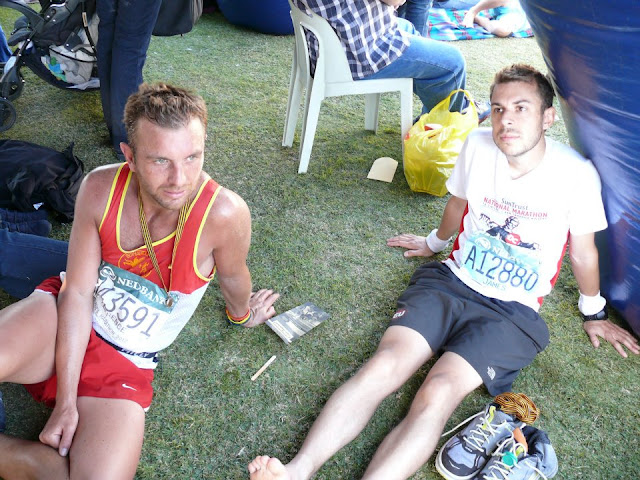 |
| Contemplation.... |
Ian had said to me before the race that until you run Comrades, you just won't appreciate what an extraordinary event it is. I totally agree with that. The support you receive on the roadside is so overwhelming it actually tips you towards getting almost emotional with it all whilst you're running. No matter where you are in the field, the crowd appeared to be going just as nuts.
No getting away from it, this is a pure road run though and if you're not a road runner, this will come as a rude awakening. I would like to have focused much more on the race but I've enjoyed just running a bunch of trail events at my own leisure this past 2 months. Running a 100 miler three weeks prior isn't great practical training but I enjoyed both equally as much for everything they offered up. Such vastly differing experiences but both totally life affirming and thoroughly awesome.
This is a must do race for all ultrarunners out there, but more than that and as per the race motto it's a must do race from a 'human spirit' perspective. Whatever South African politics have held in the past, present or will hold for the future, this race brings everyone together. Never have I felt more welcome at an event or more included in the overall experience - and there were 14,800 of us running.
In terms of times, the South African male winner came over the line in 5:31, the female winner for the 7th time was the Russian Elena Nurgalieva in 6:07, narrowly pipping Ellie Greenwood for second by around a minute. Great running from both of them. Dave Ross crept over for that much deserved silver in 7:24 at his 8th try. Terrence and I finished 950th and 951st respectively in 7:56:40 (NINE HUNDREDTH!!!!!!). Peter Bowles a Serpie traveling with us in his longest ever race ran a stellar 8:02. Rob in his first ultra of any distance 10:02 which was a phenomenal effort considering he'd been injured for months in the run up, and Jimmy came home in 11:27, wiped out but still smiling.
 |
| Ellie and Elena |
Comrades has one final sting in the tail and that is that at 12 hours dead, the gun goes and the finish line closes. We have the same rules at our events but are less brutal with how we go about it. With back turned, the finish line captain shoots the gun and people just yards or even inches from the finish are prevented from officially finishing the race. Something like 50% of people come in during that final hour and many are inside the stadium when time is called. I would have been devastated had that been me but the guys and girls who just missed out took it in there stride and relished the applause of having travelled 55.95 miles in 12 hours from dawn until dusk.
All in all this is a hard race. The course is hilly. We're certainly not talking Western States or worse here but there are very few areas of flat and not looking after your quads on route leads to big problems. If you've looked before and thought nah it's too far and too expensive, think again. The flights are economical if you book in advance and South Africa is not overly expensive to visit in terms of food and accommodation prices and is one incredible country with a lot of hope for the future. What you spend will be worth it in spades.
Credits: All photos thanks to Terrence Zengerink and family.
Written by Tom Wright - http://life.tomwright.me.uk
For ten years I have ritually travelled the AP7 from Altet airport to Denia and marvelled in awe at the strato-volcanic semblance of Puig Campana - Costa Blanca’s second highest mountain. Rising to 1400m from sea level this giant monolith takes on a more congenial form as the toll road bisects Benidorm’s suburbs, but the vast gully draining into vertical scree appears just as uninviting. A most intimidating proposition and that is where the fascination ended. Besides my true love was Montgó, a little further up the coast.
Then one evening in 2016 I watched the Vuelta tackle the long steep climb to Aitana which, at 1558m, is Costa Blanca’s highest summit. Being only a giant’s stone throw away from Puig (pronounced Putch), the seed of an idea was planted. I googled for a race that might take in both these great summits of the Marina Baixa. There were the relics of a mountain race last run in 2016 and footage of the ISF Vertical Kilometre up aforementioned gully. Finally in early May, as I was feeling the withdrawals from completing Madeira, I stumbled upon Costa Blanca Trails. A new brand and a new race based on what was already well established. No sooner had entries opened I was enrolled. No companions on this trip. A solo adventure into new territory as I would discover how majestic the Costa Blanca truly is for mountain running.
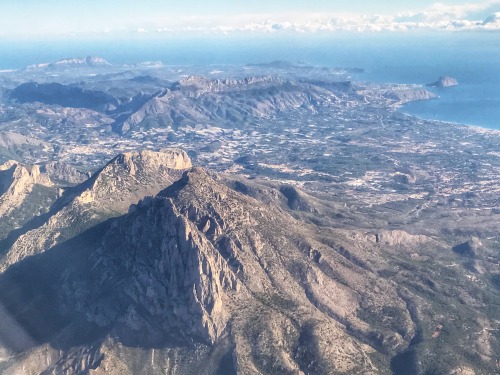
The flight into Alicante offered a bird’s eye view of the three summits I would target over three days - Puig Campana, Bérnia Ridge and in the background Montgó.
Finestrat would be my initial base, and, courtesy of booking.com, Ian and Olwen Reid my adopted parents for the first two nights of a long weekend. I don’t use that word in jest either as they cared for me beyond the call of duty. Ian got up at 5:15am race morning to make me a “breakfast of champions”; they both greeted me at the finish and revitalised me with beer and food at La Barra; drove me back to their wonderful villa nestled in the shadow of Puig itself; and prepared an evening meal - which was foiled with Rioja and highlights of the afternoon’s rugby internationals. The kindest couple and I cannot recommend enough Casa Puig as a base for anyone wanting to explore the mountains around Finestrat.
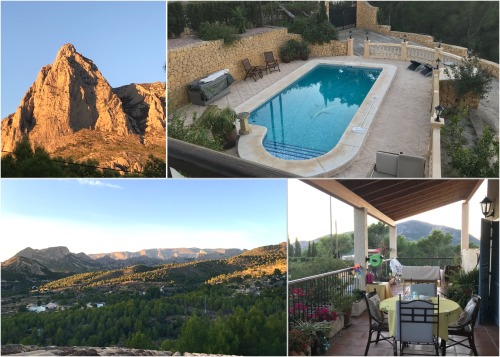
Casa Puig - (from top left) View of Puig Campana from the bedroom window; the swimming pool; the breakfast balcony; Serra Aitana from the balcony.
Anyway to the Costa Blanca Trails. There are four distances to chose from: Trail 18km; Marathon (2850m+); 65km Ultra (4200m+); and 102km Ultra (6500m+).
I chose the entry level ultra at 65km which took in both Puig Campana and Serra Aitana but excluded the Serrella range beyond the Guadalest valley. Reasons being: I was keen to have functioning legs the three days following for further exploration; I had already proved my 100km mettle in Madeira; and ultimately I wanted to see the sun rise from the summit of Puig Campana. Since the 102km started at 11pm it was not an option.
Registration was Friday evening in a small office tucked a short way down one of Finestrat’s narrow alleyways. This allowed me time to share a welcome cerveza in the November sun on Ian’s patio then familiarise myself with the one kilometre track into town, which happened to be the route off the mountain for all races and was already well marked with Scarpa branded orange tape.
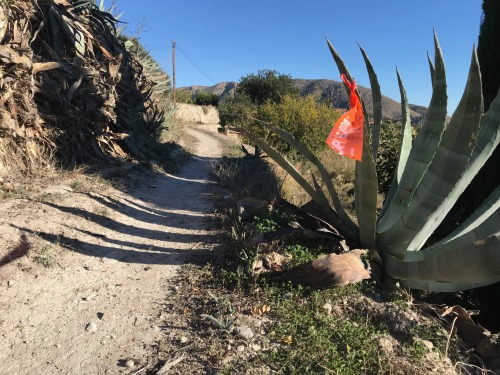
Familiarising myself with the final downhill sprint. Although, with the short autumn days, there was considerable likelihood it would be dark when I came to finish (unless I managed to break twelve hours).
Close to 900 runners had registered for the four races, nearly all Spanish. I was the only Brit in the 65km and only one of a handful of non domestic runners in the entire series of races. I am sure that will change as word the spreads.
The organisers are evidently keen to make this the de-facto event for the area and worthy of holding its own on the grand stage of global ultra running. The goodie bag had all the makings of a major European race. Tee-shirt and socks, both in my preferred tango orange, along with a light beer from subsidiary sponsor, Amstel, and the usual selection of bag tags, number and timing chips were just reward for my 60 euro entry fee. I saw little need to use the bag drop at 45km but decided a bag at the finish would be essential since Spain is “a cold country with a hot sun” (not my words) and sundown was 6pm.
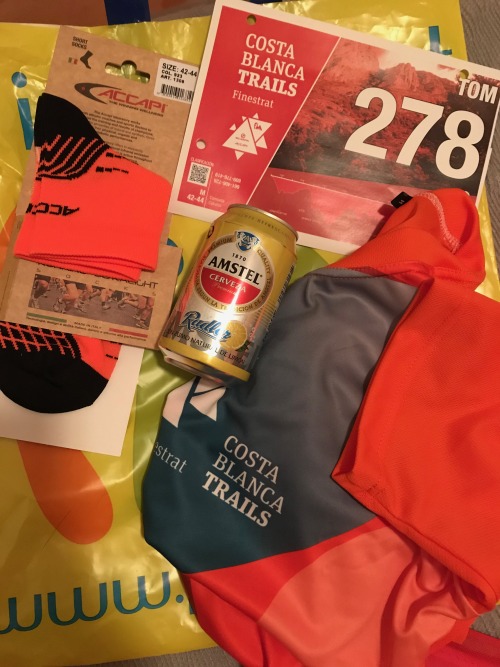
Yes Tango Tom is one happy customer!
Ian is actually a former runner himself having lived and raced in Benidorm and the surrounding area since the 70’s. He clearly understood the need to carb up before a race as he served up yoghurt, raspberries, honey, toast, tea, fruit and sponge cakes for breakfast at 5:30am. I had intended on munching a banana and Gu waffle so this was a most unexpected treat.
I jogged down to the start line just after 6am by the light of my Petzl Nao wrapped in my Montane Prism coat to take away the slight chill in the air. One by one we were marshalled into a caged area via a kit inspection. A happy Spaniard expressed some happy Spanish which I did not understand but suspect was along the lines of -
“you have a very big bag, a lot of water and nothing else”!
Which would be true. Kit list as follows: cup; head torch with spare battery; wind jacket with hood; foil blanket; bag min 3 litre capacity; at least 1 litre of water; emergency food; buff or hat. So not needing the full waterproofs, gloves and spare layers typical of a British race in November I had plenty of space in my 10 litre s-lab pack to add additional water vessels. Two soft flasks up front and a hand held in my kangaroo pouch. Along with quite a selection of Spanish gels, which I had picked up in Consum on our previous visit two weeks earlier, and the aforementioned Gu waffle that was now surplus to breakfast requirements. Learning from my previous experience at MIUT, I had packed away my wind jacket and donned just a mesh vest and arm warmers. This race was only going up so, despite the low air temperature, I expected to break sweat in no time. I also abandoned a tradition of my long distance running… 2XU compresssion and trail shorts. After all this is Spain and the quads deserved a bit of vitamin D!
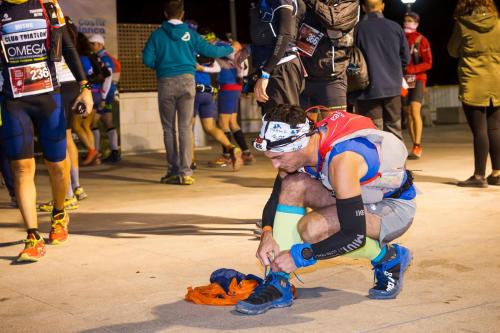
Pre-race lacing - a nervous disposition!
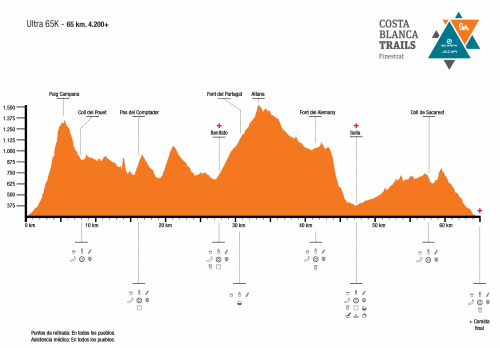
Profile of the Costa Blanca Trails 65km. Two major climbs, the first being a VK; a couple of deceiving climbs in the middle; one very steep descent to Sella; and a 5km downhill finish.
Finally ahead of 6:30am we were marshalled out of the cage and under the starting inflatable. This time I did understand the Spanish as the announcer asked us to move forward as all but the elites hung a comfortable distance back. I had no intention of getting stuck in the usual melée of a European sprint start and nestled near the back casually making my way over the start line following the hooter. As soon as we were away from the crowd of villagers that had awoken early to support us I took to walking the tarmac road out of town.
Is there any point running when you imminently face an ISF VK? Beyond Font del Moli there was even a sign, adorned with ISF logo, heralding the expectant change in gradient. I probably should have taken a photo but feared stopping even for a second may have a drastic knock-on effect on the single file line of traffic that had now formed behind, and ahead of, me. So we would climb 1000m in 3.5km - yes this VK really meant business!
What a way to start a morning’s mountain running on the Costa Blanca!
I had no expectations or plans for the day other than to enjoy myself and discover some new hiking trails that I could return to and expand on in the future. The VK, scree and all, was just a taster of the climbing that lay in store as our route meandered through the Marina Baixa interconnecting a number of cols that allowed as to bisect ridge lines of sharp uninviting pinnacles and tall buttresses of white rock. The tracks a mix of fire road, Mozarabic trail, indiscernible mountain trods and tarmac, led us through olive groves, mountain pastures, rocky boulder fields and several mountain villages. Water and aid stations were well placed along the route although I quickly found myself turning to the gels in my pack for energy as the heat of the sun made dry food unappealing.
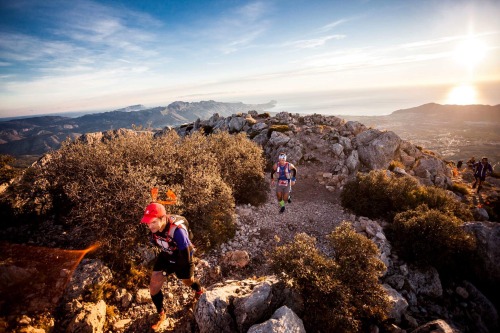
Cresting Puig in the orange glow of a Mediterranean sunrise and the realisation that Benidorm’s skyline is eclipsed by the majestic mountains concealed behind. A just reward for anyone venturing to Puig Campana’s summit. At 1408m, and only ninety minutes into the race I had already climbed higher than The Ben.
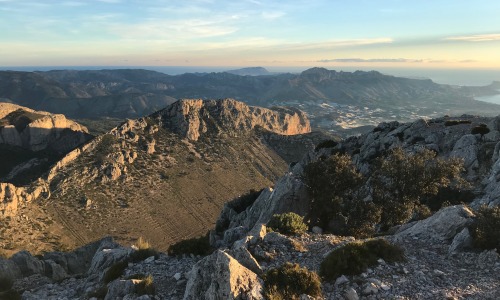
Ponotx’s kinder side, Bérnia and Montgó omnipresent in the background.
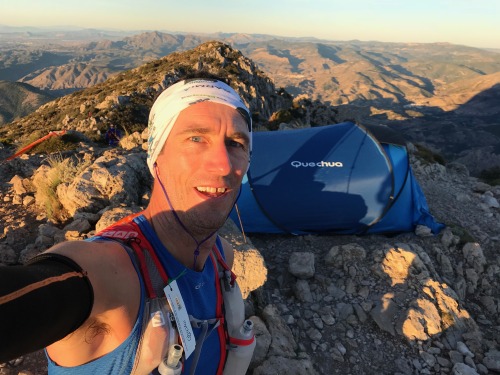
A marshal had been camped out on Puig’s summit since the 100km race had passed through in the early hours.
Puig Campana made excellent work of dispersing the field however I rarely found myself without company and as fate would have it saw the female race unfurl around me as I shared the Penya de Sella ridge with the second lady, who would eventually go on to win, and the long climb back to Puig along the PR-CV 12 with the, then, leading lady. Conversation was sparse as my Spenglish did little but confuse!
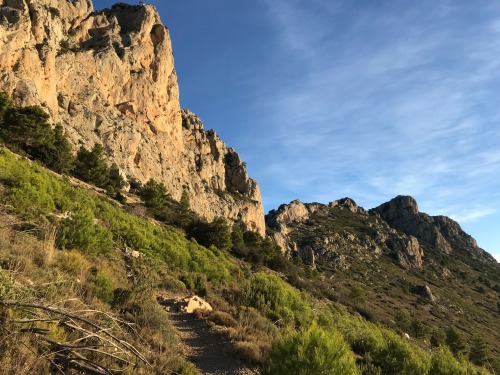
Heading for Col del Llamp below Ponotx’s western ridge.
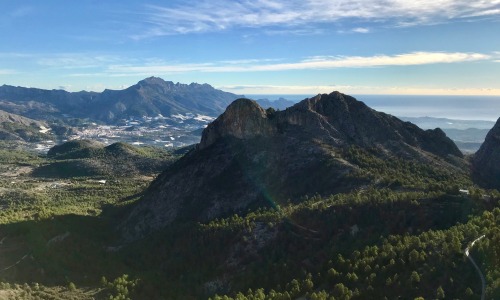
Penyo de Cabal and Bernia
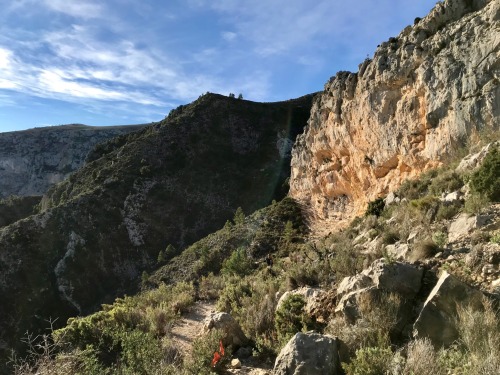
The tall white buttresses …
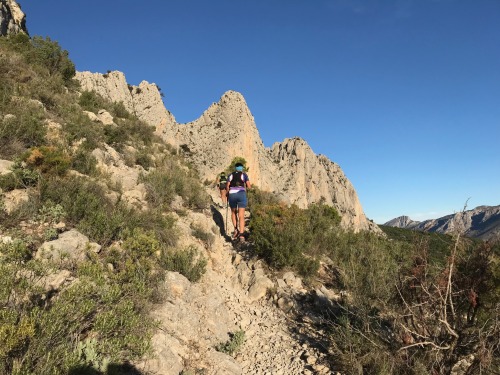
… and jagged pinnacles make up El Carrascal
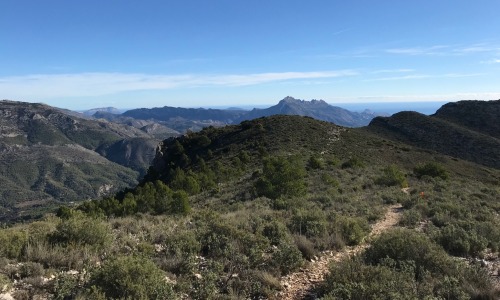
The view from Port de l’Arc. One of the lesser but none the easier climbs in the middle of the course.
Of course the pinnacle of the day was Aitana. The climb was long and tiresome. Fortunately the aid station, just 2.5km out of Benifato, was complemented further up by fuente’s (water fountain) that offered a refreshing dunk under ice cold runoff. There was always an impressive vista to distract from the exertion with the Bérnia ridge and Montgó omnipresent on the northern horizon. Approaching the false summit of Aitana (the true summit a closed military installation) we passed under the shadow of pine trees. At 5000 feet and with an absence of heat as the winter sun passed too low through the sky the trail was littered with frost. A first for me in Spain!
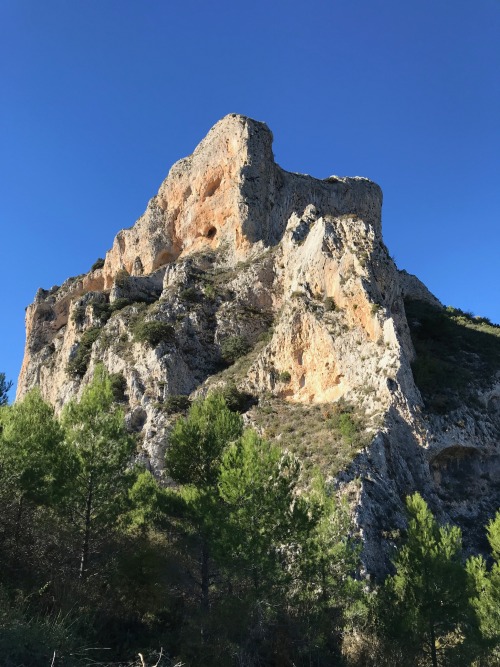
One of the tall pinnacles comprising the Partagat
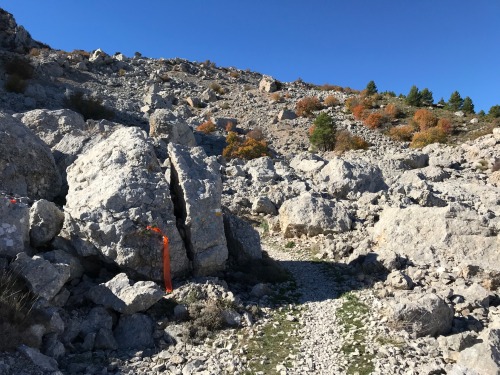
As the climb briefly levelled off the track gave way to boulder fields.
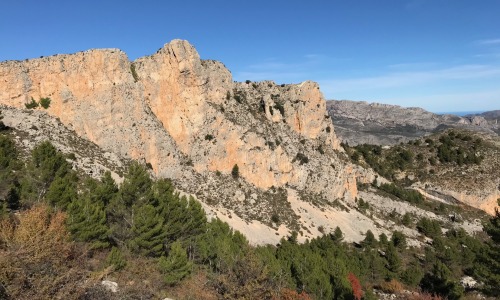
Imposing buttresses on the Partagat looking across to the Serella
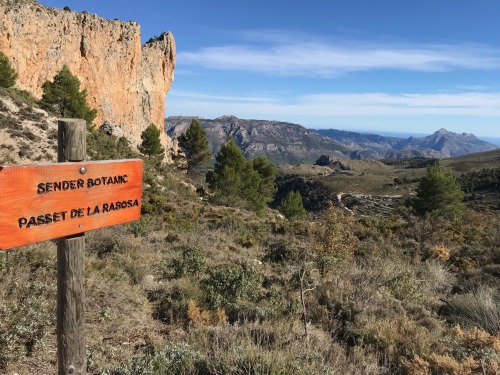
Looking back across the Guadelest valley to Serella and Bernia
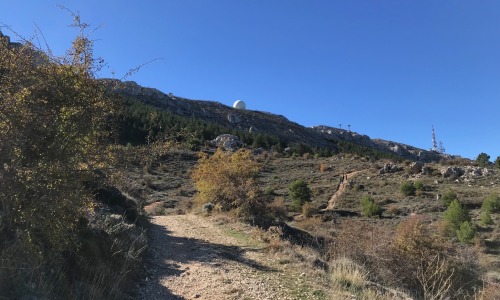
The “golf ball” on Aitana’s summit
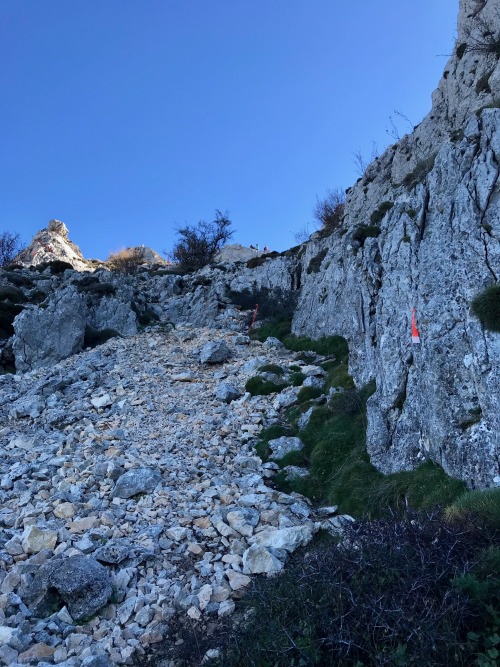
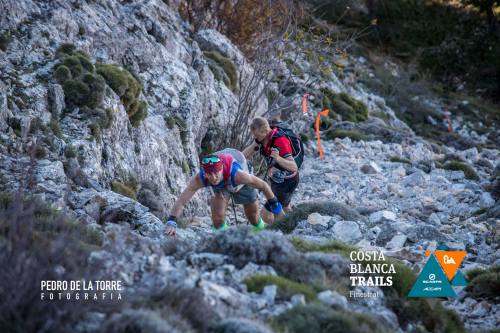
The scree and scramble to Aitana’s summit in the company of one of the two Brits on the 100km course.
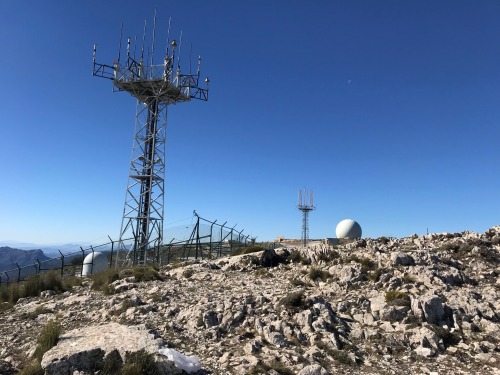
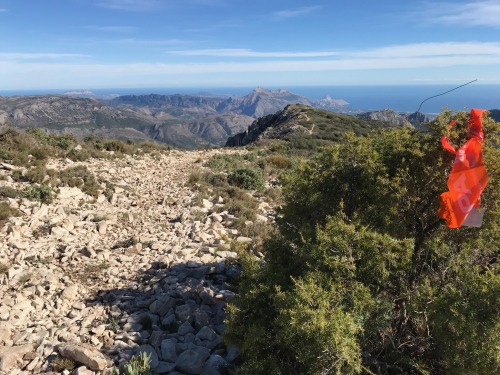
From the summit the view was impressive! Far away across the water we could make out Ibiza (not in the photo though!) while to the north-east Montgó was omnipresent.
The terrain on top was similar to Montgó’s own plateau with a barely discernible path over sharp and jagged limestone rock. I was in my element and once again picking off runners.
The back half of the course was dominated by fire road and long gradual descents/ascents. Which probably explains how I managed for the first time in a race to negative split as my average pace fell from 20 to 15 minute miles. Fortunately the ever changing landscape was a distracting lure from the monotony of the road. It was also broken up by a couple of very exciting descents.
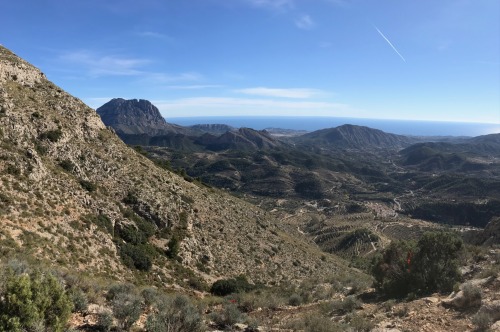
The start of the descent to Sella. Puig in the background.
Of which the barely perceptible track from Coll de Travessa to Sella was the most technical of the entire route with plenty of insecure rock and scree to lose footing on. Ahead of me a runner fell hard on his back. “Estas bien?” I enquired. He did not respond. “Vale?” I tried. Still no response. Third time lucky: “You OK?” “Yeah but this is no fun with 80km in my legs!” It was another Brit, in fact I believe the other Brit of the two that were in the longer race! I had no time to stop and talk. I was putting into practice the techniques and skills I had perfected mastering Montgó’s eastern descent, and again passing numerous runners, as I skied the scree and tip-toed over the jagged limestone. The legs felt good and in no time I had covered the 2000 foot drop into the hot feed station at Sella. My confidence in my descending only grows and as a little race within the race I was stoked to find my way into another Strava top 10 (despite a long overdue toilet stop half way down!)
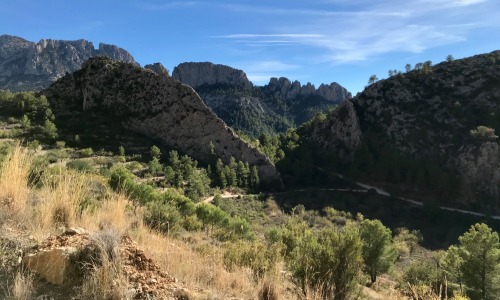
The jagged towers of the Castellets
The dream finish wasn’t to be as, no sooner did I hit the long downhill to Finestrat, I cramped up. The fire roads and the steep switchback ascent onto Puig’s north-western wall had taken its toll and the legs were exhausted. I refused to give up though and following some painful stretching I was able to run the cramp off and maintain enough pace to cross the finish line in under ten hours. A race with no expectations other than to enjoy myself and finish before sundown and I just finished in the top 10 veterans!
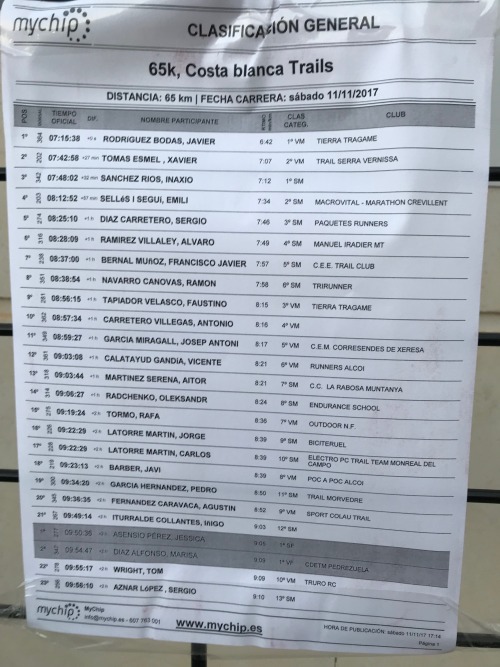
First time my name has made the first sheet at a European mountain race
It was the usual electric atmosphere at the finish with music pumping and Spanish voices filling the air. A vast dish of paella was under constant supervision. I was starving, it was free, so I did not object picking around the large chunks of meat that dominated my plate! Sometimes it helps to be British as the barman saw my needs and kindly gave me a second beer on the house.
Tired, dehydrated and a little deranged how lucky I was to be whisked up by Ian and Olwen for food, more beer and ultimately a long night of sleep ahead of three more days of hiking in the Costa Blanca. Having been in my peripheral vision for much of the day, the Bernia Ridge and Montgó were calling.
I hope the photos and my words have done this event justice as the Costa Blanca Trails is a truly excellent race with challenging climbs and ultimately stunning views. Well worth checking out!
Page 8 of 33











